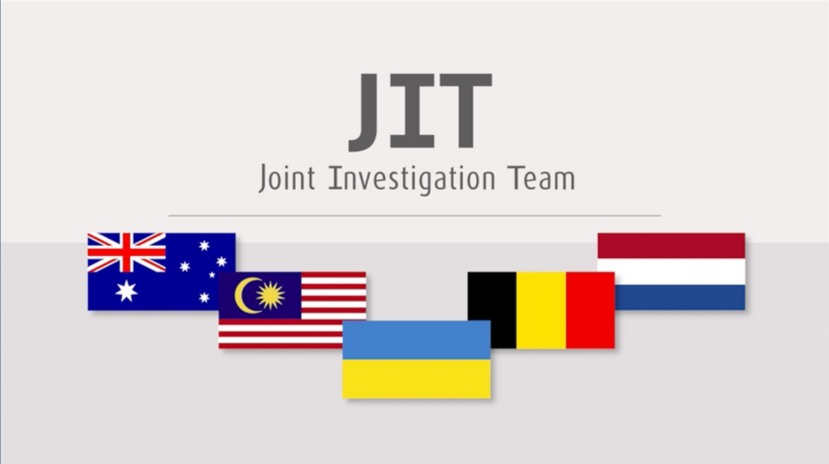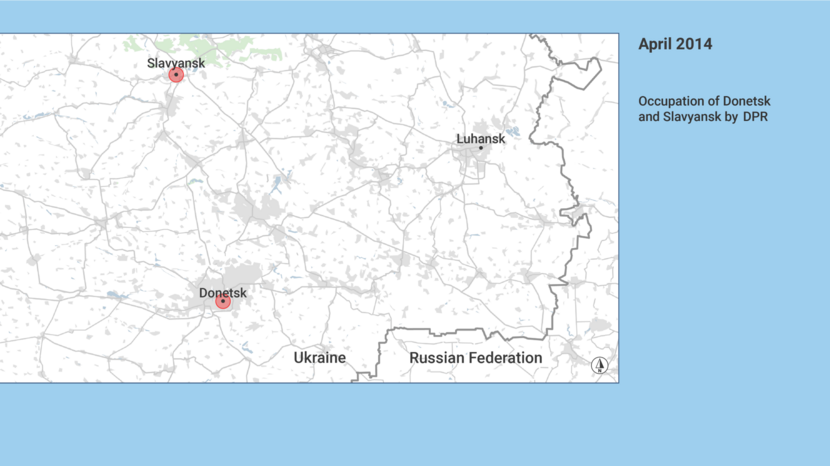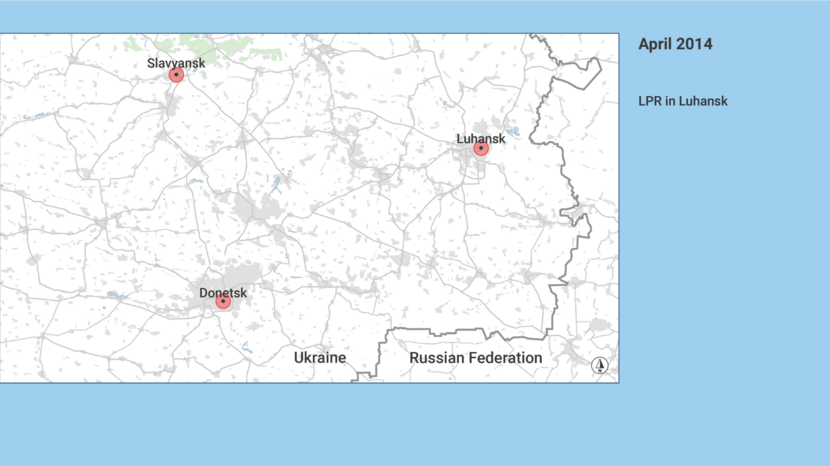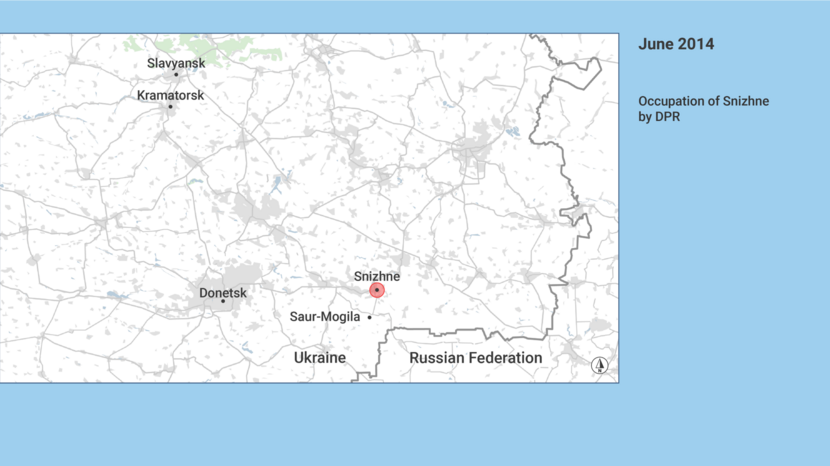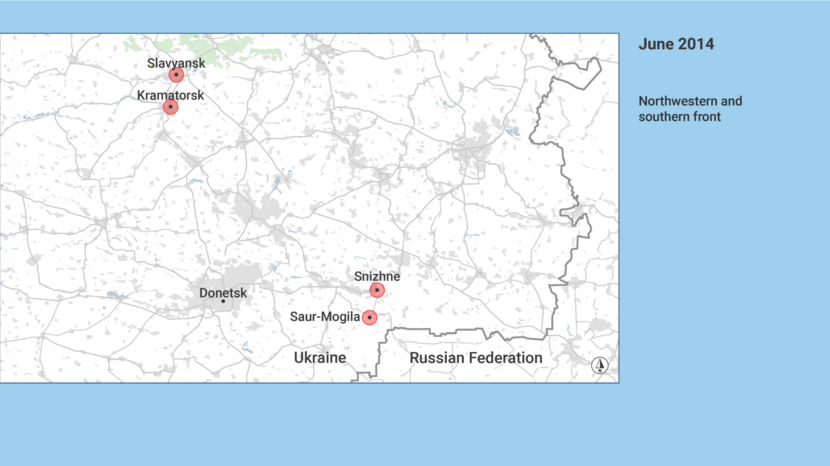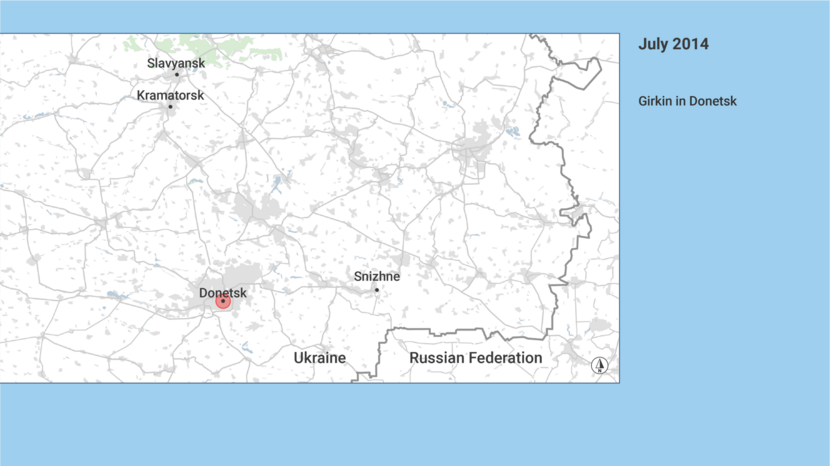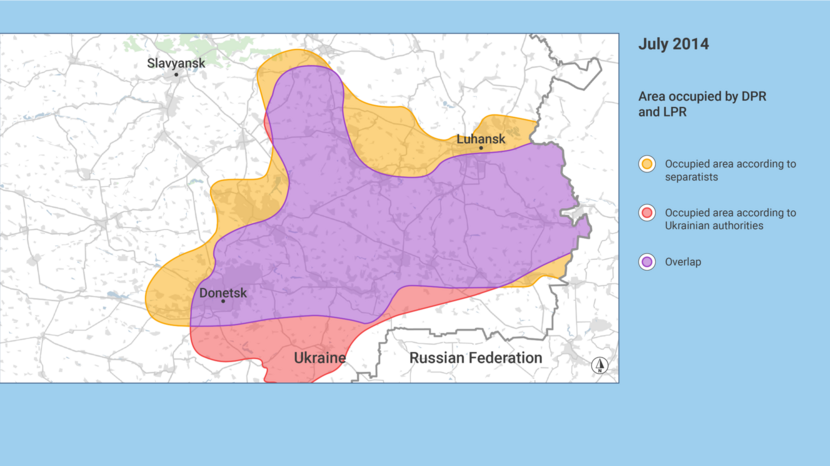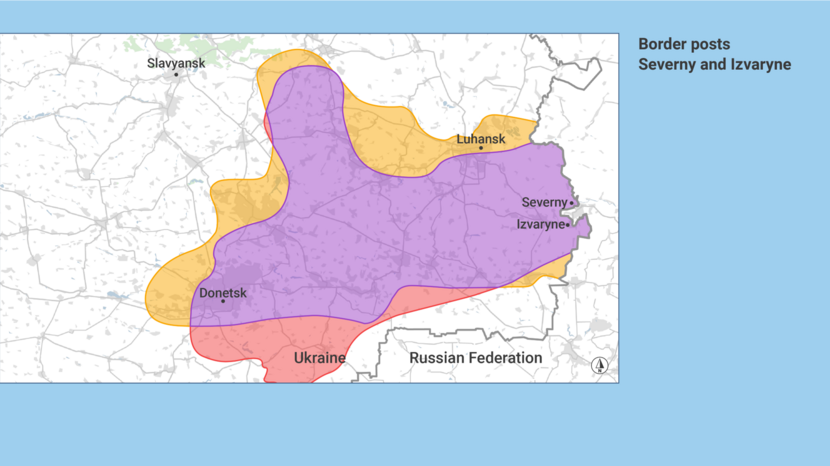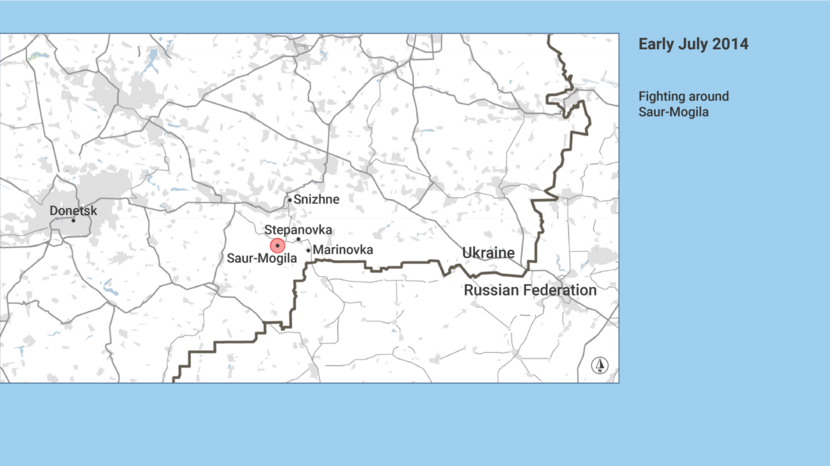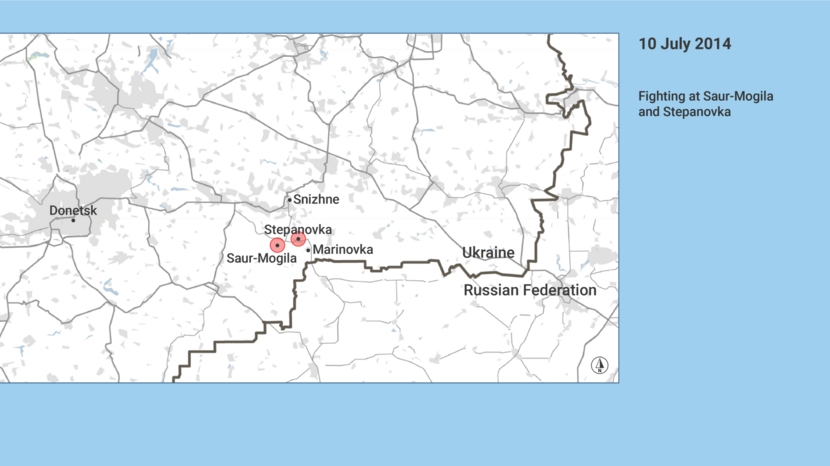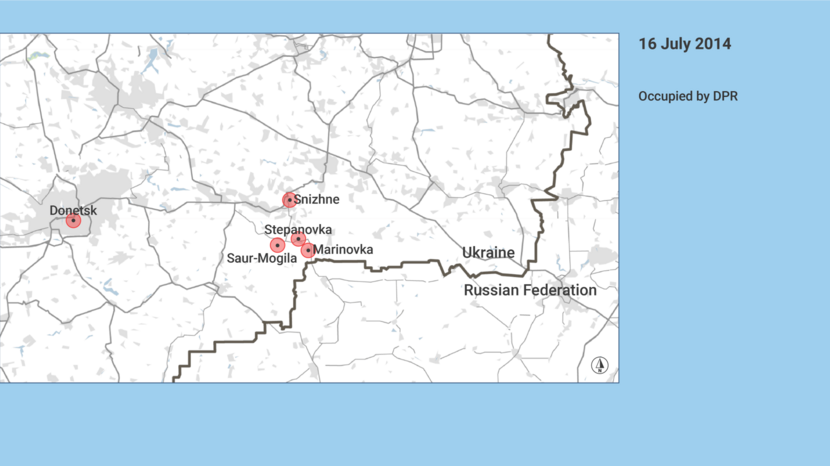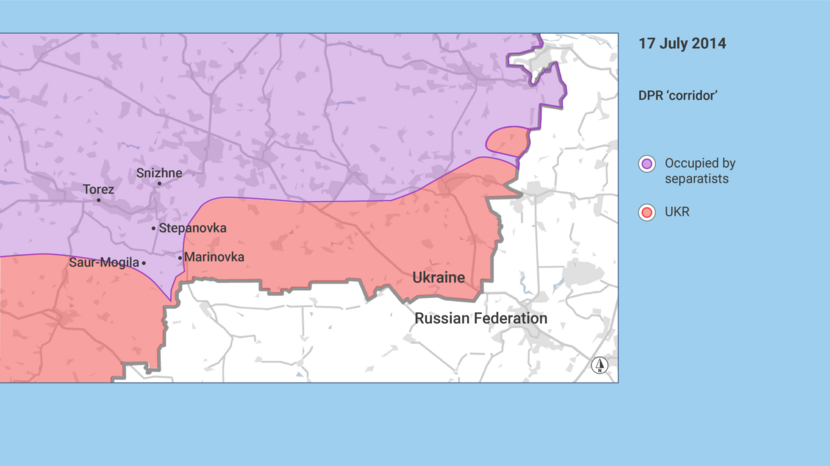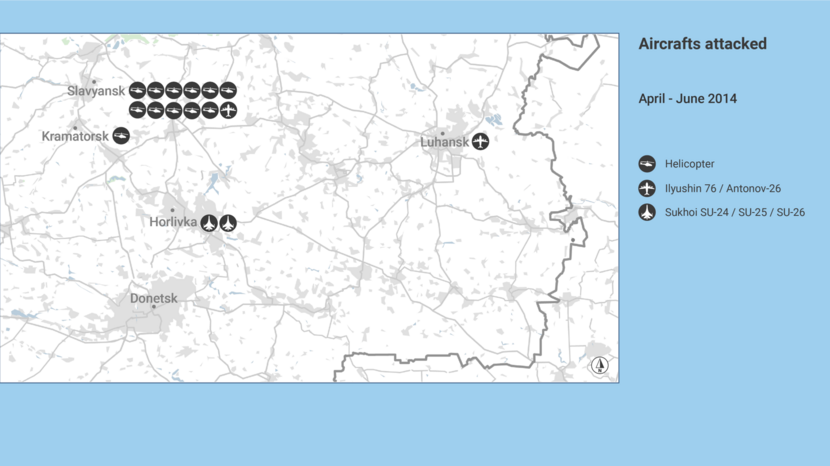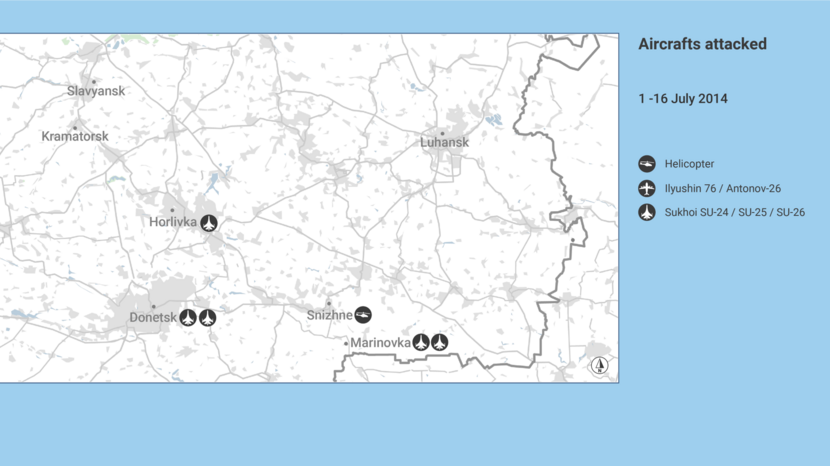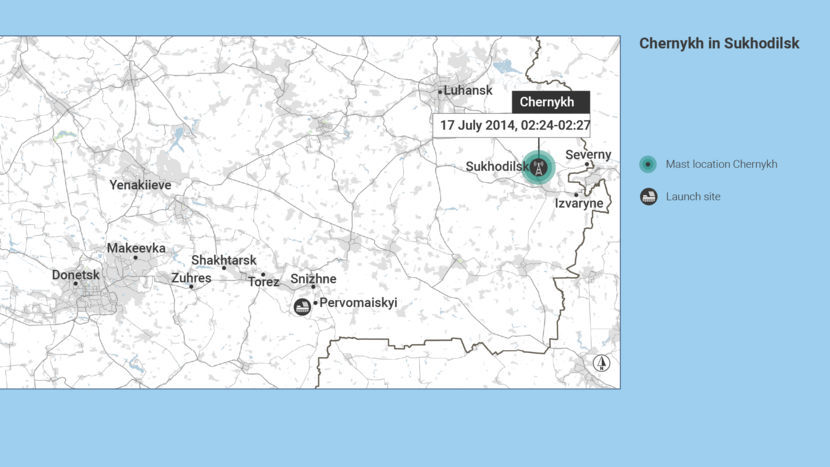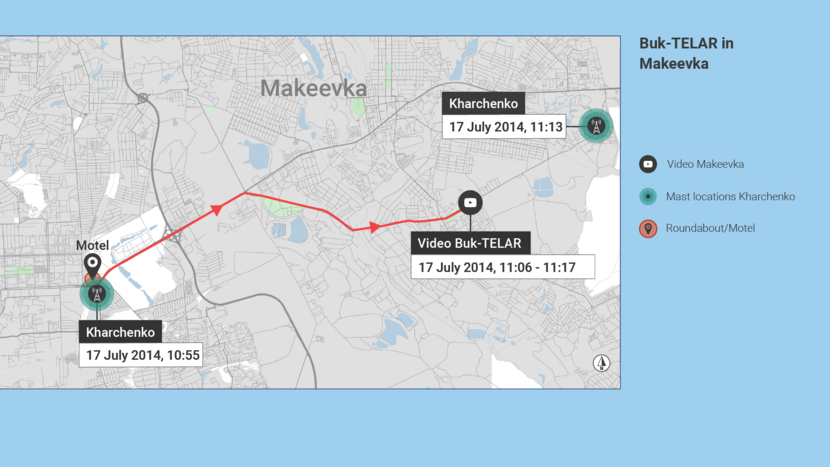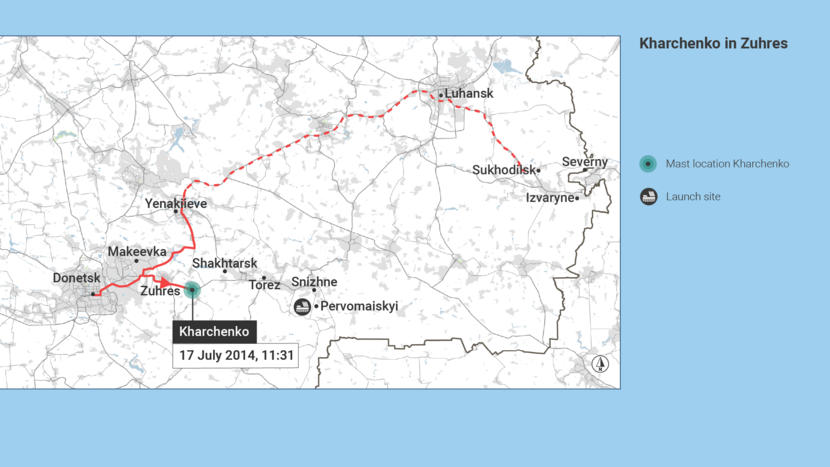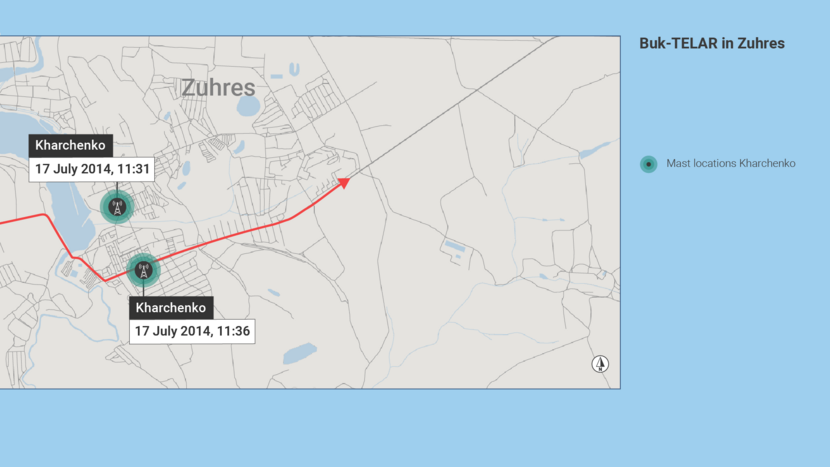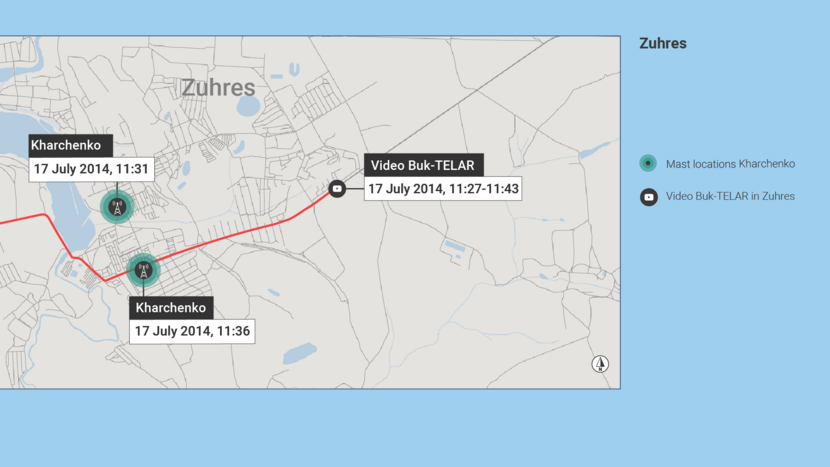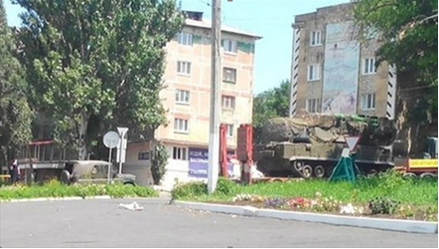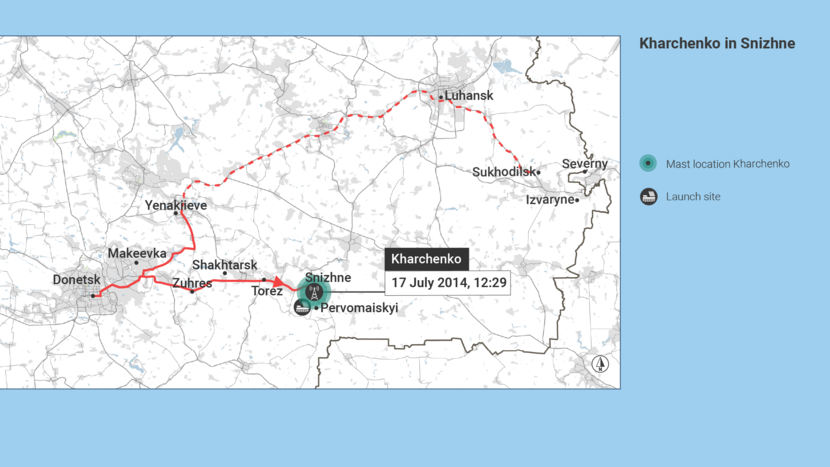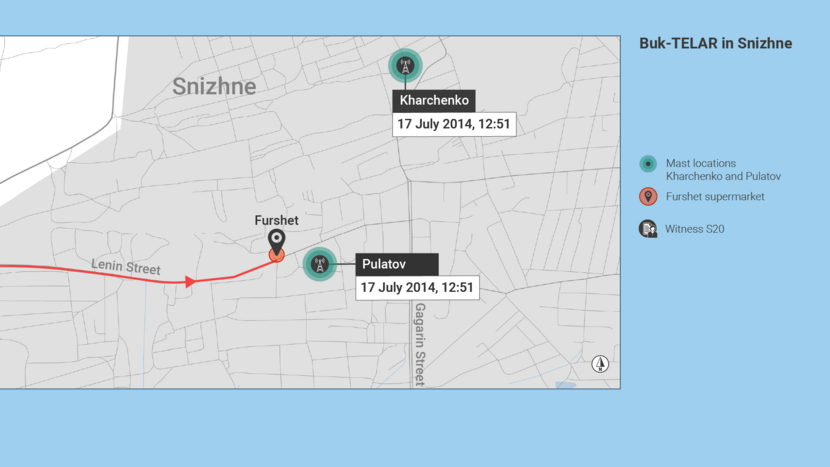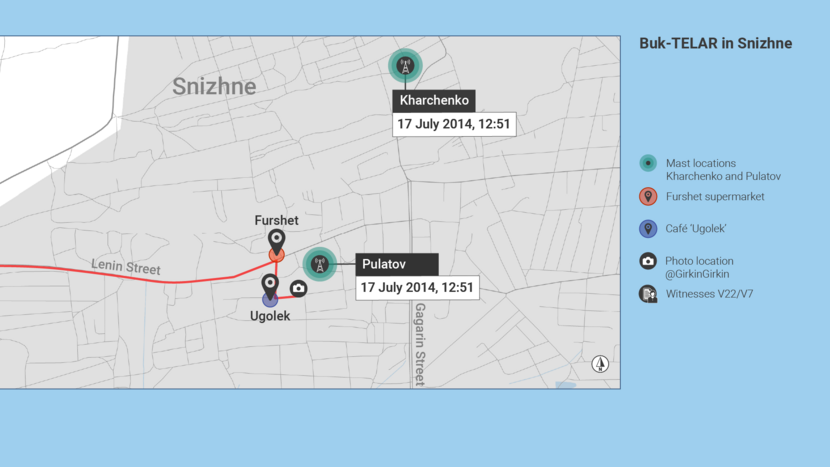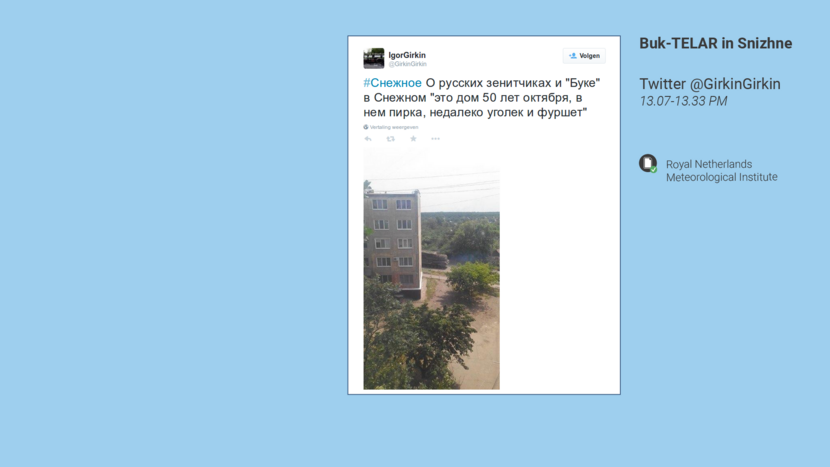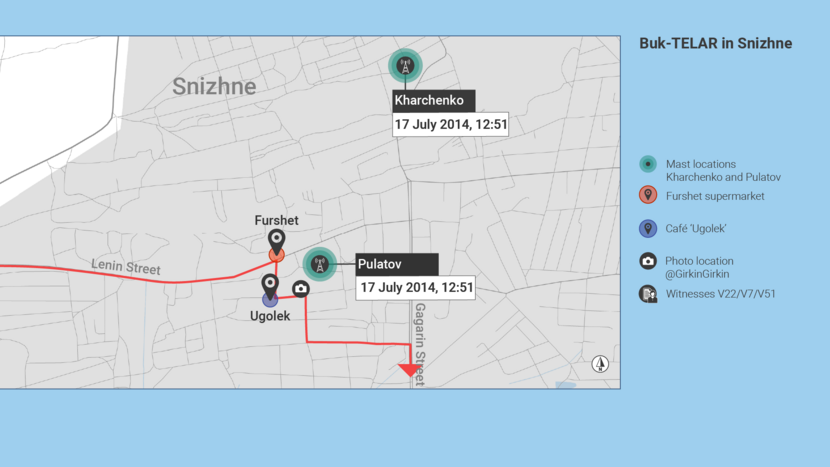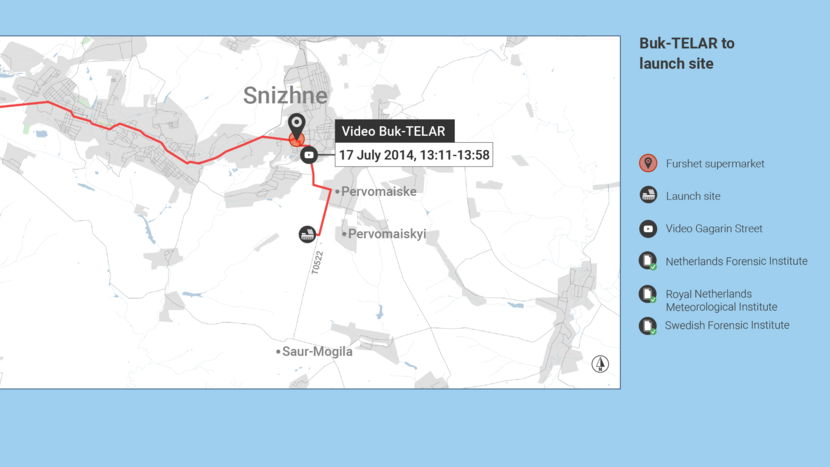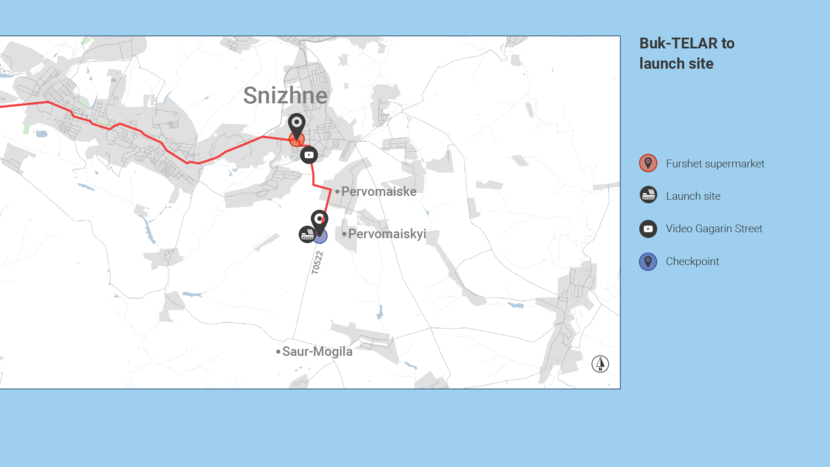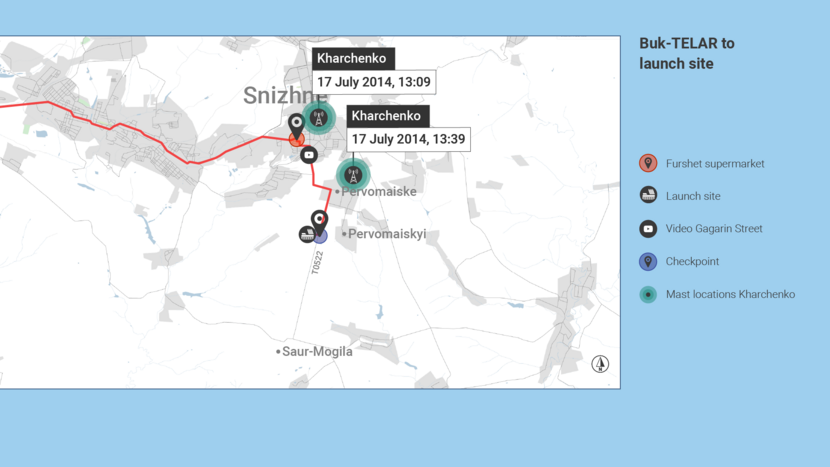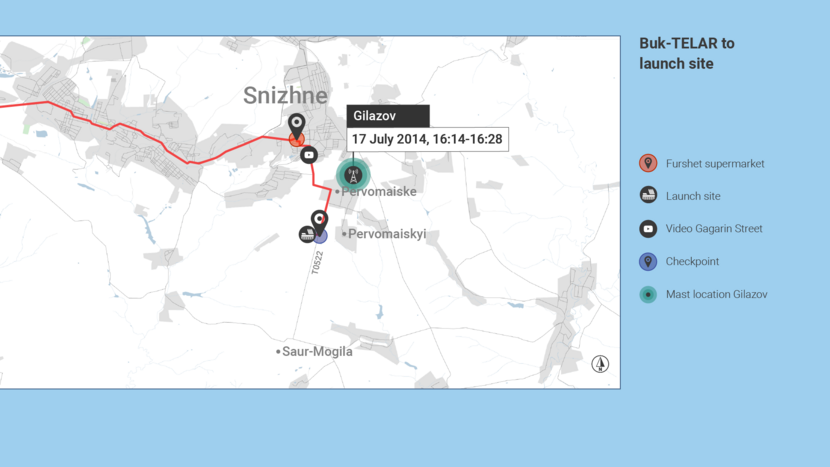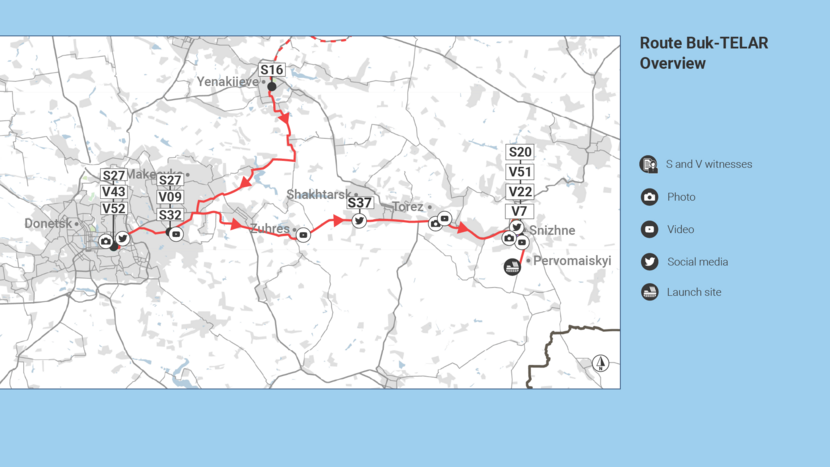Closing speech Public Prosecution Service day 1 (20 December 2021)
On Monday 20 December, Tuesday 21 December and Wednesday 22 December 2021 the Public Prosecution Service presented its closing arguments in the MH17 case. For the presentation on day 1 please read the text below or watch the video (in Dutch with English interpreter).
1 Introduction to closing speech
The 17th of July 2014 is a warm summer’s day. At Schiphol Airport in Amsterdam, 283 passengers are checking in for a Malaysia Airlines flight to Kuala Lumpur. It’s a varied assortment of people: grandparents travelling with playful kids, freshly graduated high school pupils, eager to take one last selfie before they fly. Young couples, retired people, families of all shapes and sizes. A nun, a Malaysian ship maintenance worker off to celebrate a Muslim holiday with his family, a young soldier off to Bali to visit his brother.
Several thousand kilometres away, in eastern Ukraine, the four men on trial here are preparing for a fresh day of violence. Tanks are being transported, scouts positioned. A white truck drives in an armed convoy from Donetsk to Snizhne. Hidden beneath its camouflage netting is a missile installation, a Buk TELAR. Today the separatists hold a trump card.
At Schiphol Airport, meanwhile, the passengers have now boarded the aircraft. Some are reading about their dream destination; others are making notes for the international AIDS conference they are attending in Melbourne. Others are letting their families in Malaysia, Australia or Indonesia know that they’re on their way. The fifteen crew members of flight MH17 are doing what they always do: welcoming the passengers, taking the plane into the air and making sure the flight is as comfortable as possible.
The flight has been under way for less than three hours when, at 13:20 UTC (16:20 local time) air traffic control in eastern Ukraine loses contact with flight MH17. At that instant a Buk missile warhead detonates at the top left side of the cockpit. Fragments and missile parts penetrate the left side of the cockpit, and the resulting pressure wave does the rest: the aircraft’s fuselage breaks into several pieces and falls to the ground. The passengers and crew of flight MH17 don’t stand a chance. While family members following the flight from countries including Australia and the Netherlands see MH17 vanish from their flight trackers, separatists in an agricultural field near Pervomaiskiy congratulate each other, believing they’ve shot down an enemy aircraft.
On 17 July 2014, the 298 occupants of flight MH17 became victims of a conflict which continues to this day, and has now cost over 13,000 lives. A conflict that has torn Ukraine apart, disrupting and destabilising its society. A conflict that is still greatly impacting daily life in Ukraine itself and far beyond, in all the countries that are home to the friends and family of those aboard flight MH17.
The Public Prosecution Service deplores the deaths of all the victims of the conflict in eastern Ukraine, but we are here today seeking justice for the 298 victims of flight MH17. It is the court’s task to establish how MH17 was downed on 17 July 2014, and whether the defendants Girkin, Dubinskiy, Pulatov and Kharchenko bear criminal responsibility for it or not.
This autumn, various next of kin told the court that this case is important because it can help them to come to terms with the deaths of their loved ones. ‘To try to make some sense of what seems so senseless’, as an Australian family member put it. When exercising their right to be heard, several of the next of kin also stressed that the disinformation surrounding the downing of flight MH17 was disrupting the grieving process. A court judgment would at least give them clarity and peace.
Establishing what really happened also serves a broader interest. As we noted on the first day of this trial, establishing the truth in this case can also help prevent new violence in the future. After all, a world that doesn’t take the trouble to establish the truth and punish the guilty when hundreds of innocent people are murdered is effectively announcing open season on the general public. This is another reason why truth must be distinguished from lies, and perpetrators punished. That is why we are here in this courtroom.
Besides the interest of the truth, the victims and the next of kin, the Public Prosecution Service also serves the interests of the four defendants it is prosecuting, as provided for by law. This requires that we critically assess the available evidence, adopt an open-minded outlook, listen carefully to the defendants’ positions, and guarantee they receive a fair trial. A balanced but critical assessment of the evidence is an interest that the defendants and the next of kin share. No one in these proceedings has anything to gain from the conviction of an innocent person, or a judgment that will not stand the test of time. For that reason, since the first day of this trial, the Public Prosecution Service’s approach has been compassionate but objective.
Over the next days, we will give our vision on the results of the investigation. Our closing speech will consist of four parts:
- Investigation, prosecution and trial
- Evidence and criminal liability
- Damages claimed by next of kin
- Sentence
Today we will deal with part one, and we will make a start with part two. In part one (‘Investigation, prosecution and trial’) we will discuss the course of the investigation and the manner in which the evidence obtained in that investigation was assessed. Next we will reflect on our decisions concerning the prosecution of these four defendants and the way in which the criminal proceedings unfolded. In part two (‘Evidence and criminal liability’) we will discuss the evidence and the degree to which the defendants are criminally liable and their actions punishable by law. In the process we will consider the facts that emerged from the investigation. Tomorrow we will finish part two. Then we will reflect on the defendants’ statements and standpoints, we will discuss possible evidential defences and draw conclusions on the true circumstances of the crash and the involvement of the defendants, the definition of the offences and the criminal liability of the defendants. We will also discuss part three: the damages claimed by the injured parties and the items under seizure. The day after tomorrow we will conclude with the fourth and final part of our closing speech: the recommended sentence.
On the first day of the trial, in March 2020, we made reference to the Russian writer Alexander Solzhenitsyn who, when accepting the Nobel Prize in Literature in 1970, spoke about the relationship between violence and falsehood. One of the family members cited this Nobel Prize winner on the first day of the next of kin’s statements. Solzhenitsyn also wrote about the importance of fighting injustice. We will close our introduction today with his words.
In keeping silent about evil, in burying it so deep within us that no sign of it appears on the surface, we are implanting it, and it will rise up a thousandfold in the future. When we neither punish nor reproach evildoers (...) we are thereby ripping the foundations of justice from beneath new generations.
2 Investigation, prosecution and trial
2.1 Introduction
As noted, we will begin by reflecting on the course of the investigation in which the evidence in the cases of the four defendants, Girkin, Dubinskiy, Pulatov and Kharchenko, was obtained, and on the decisions the Public Prosecution Service made on the basis of that evidence in order to bring these cases before the court. Next, we will discuss the course of these criminal proceedings. In particular, we will consider the protection of the defendants’ rights and interests during this trial.
In doing so we will also discuss several topics mentioned previously in these proceedings, for example when the trial began, and during our detailed explanation of the investigation in June last year. Although we wish to avoid unnecessary repetition, these topics must inevitably be revisited because they are important with a view to the public's proper understanding of the Public Prosecution Service's actions in this criminal case.
2.2 Course of the criminal investigation
First we will look at how the criminal investigation proceeded. This began shortly after flight MH17 crashed.
2.2.1 Joint Investigation Team
The investigation is conducted by an international Joint Investigation Team, or JIT. The team includes five different countries, which had all been affected by the disaster: the Netherlands, Australia, Malaysia, Belgium and Ukraine. The JIT format enables the countries concerned to coordinate their activities, perform them jointly where efficient, and share evidence and information without unnecessary bureaucracy. In addition, each country retains the freedom to conduct its own investigation and analysis. In the Netherlands’ investigation, for example, threatened witnesses were examined by the Dutch examining magistrate.
It will not surprise anyone to learn that this form of cooperation could be complex at times. JIT partner Ukraine, for example, is itself involved in the conflict within which the downing of MH17 occurred, and is even held responsible for it by some. For this reason it was essential that the Ukrainian investigation team open every door to its JIT colleagues. And that is what happened. Ukraine understands better than anyone how important it is for evidence from Ukraine to be gathered in cooperation with the other, neutral JIT countries and critically assessed by those other, neutral JIT countries. For Malaysia, a legal obstacle had to be removed before it could join the JIT. The country first had to guarantee that it would not demand the death penalty in the event that a prosecution should subsequently take place in Malaysia. Furthermore, the JIT countries had to work together in a range of locations: Driebergen in the Netherlands, where the regular consultations among the JIT partners were held; the Field Office in Kyiv, where Ukrainian, Australian and Dutch detectives conduct joint investigations; and at various other locations in the Netherlands and Ukraine where experts from all the JIT countries conduct technical investigative activities. Despite these challenges, the cooperation among the partners proceeded successfully. The partners always reached agreement on the investigative activities to be performed and major efforts were made to conduct those activities and if witnesses wished to be interviewed by one JIT-country, but not by another, this could be accommodated as well. In short, thanks to the JIT, a full and efficient investigation could take place.
2.2.2 Validation
From the very beginning, the JIT conducts a wide-ranging, in-depth investigation. A forensic investigation was performed on the bodies of the victims and the wreckage of MH17. Hundreds of witnesses were interviewed in different countries. The investigation examined telecom data, satellite images and radar data, photos and video, and information from public sources.
From the outset it is clear that the ongoing conflict between Russia and Ukraine will influence the way in which the findings of the investigation would be received. For this reason we took additional steps, spending even more time on the investigation and evaluating the evidence even more stringently than we would otherwise have done. This was done in various ways.
First, we assessed the reliability of individual findings of the investigation in various ways.
For example, Ukrainian telecom data was investigated by verifying the content, time and location data of telephone conversations. This verification was done by comparing the data with other telecom data and with information from other sources, and by ascertaining whether the participants could verify the recordings of the conversations. We succeeded in doing the latter in several cases. The JIT identified a number of participants in recorded conversations and interviewed them as witnesses. Various participants confirmed (for example, in interviews) the authenticity of intercepted conversations which were publicly disclosed. In addition, telecom data was requested from providers in other countries, enabling investigators to check whether the Ukrainian telecom information about international calls is factually accurate. The phone mast data provided by the Ukrainian authorities was also compared with data from network measurements performed by Dutch specialists in eastern Ukraine. Our analysis of the intercepted conversations we received extended to conversations that were not directly relevant to the evidence. This makes it possible to confirm many details in the conversations. This in-depth validation of the telecom data provided by Ukraine was time-consuming, but thanks to the quantity of telecom data, the broad analysis it was subjected to and the way the various pieces hung together, it provided a solid foundation for the court’s assessment of that data.
The visual material was also subjected to extensive validation. In each case, investigators endeavoured to find the people who had shot these photos and videos and to interview them as witnesses. In some cases we were able to do so, and in others we were not. In some cases we were able to interview people who were present when the material was recorded or who were involved in disseminating the material and could thus confirm its origins. If possible, the camera in question (including the memory card) was seized and handed over to the Netherlands Forensic Institute (NFI) for study. Whenever it made sense to do so, the NFI examined the material to see if there were any indications that it had been manipulated. Visual material was also shared with the Royal Netherlands Meteorological Institute (KNMI). A KNMI expert investigated the shadows, light and cloud cover on the images. On this basis the expert assessed whether the weather in the photo or video is consistent with the weather at that particular location on 17 July 2014, and approximately at what time the photo or video must have been shot. Finally, the recording location of the visual material was investigated. This was done by comparing what is shown in the images with what can be seen in open-source material, such as Google Streetview or satellite images. The investigation team established a geographical location for each of the photos and videos it examined.
Every type of evidence, from videos to intercepted telephone conversations and from forensic evidence to witness statements, was validated with the greatest possible care.
In addition to testing the results of the investigation individually, all these various sources of evidence were also compared with one another and described in the case file in relation to each other. This made it possible to identify relevant similarities and differences. With that aim in mind, we assembled a wide-ranging case file, in which the results of the investigation can be judged in light of one another and in the proper context. This is why the case file also contains a wealth of information about the course of the armed conflict which formed the backdrop to the downing of MH17. When these different sources of evidence are assessed in relation to each other, they often dovetail remarkably neatly, and as such reinforce each other. This will be highlighted again shortly, when we come to discuss the evidence.
2.2.3 Alternative scenarios
During the investigation the evidence is gathered on the basis of various scenarios. These scenarios were drawn up at the start of the investigation and investigated in a targeted manner. Each scenario posits a different cause of the crash of flight MH17. The team investigated the possibility that an explosion occurred inside the aircraft, that the aircraft was attacked by a combat aircraft (the ‘air-to-air’ scenario) and that the aircraft was shot down by a surface-to-air missile (SAM). The last of these scenarios was then subdivided into two possibilities: an attack by a Buk system or an attack by another type of SAM. With respect to the Buk scenario, we investigated various possible launch sites, both in the area under the control of Ukraine and in the area under the control of the self proclaimed Donetsk People’s republic or DPR. After a lengthy investigation into all these possibilities, only the last of these scenarios was found to hold up. To be exact, the launch of a Buk missile from an agricultural field near Pervomaiskyi.
At the hearing in June last year we considered in detail the course and findings of the investigation into alternative scenarios. Since neither the JIT investigation nor the supplementary investigation ordered by the court at the defence's request has yielded anything whatsoever to satisfactorily establish any scenario other than that MH17 was shot down by a Buk TELAR from an agricultural field near Pervomaiskyi, we will confine ourselves in this closing speech to the evidence pointing to that main scenario and the defendants’ responses to it, both within and outside this courtroom. After all it is this scenario that is the foundation of the indictements, and therefore the scenario that the court will have to assess.
2.2.4 Evidence from Ukraine
As noted, we have tested the evidence in this case even more stringently that we would have done in other investigations, because the various parties to this conflict each have an interest in the outcome of the investigation. Furthermore, for some time there have been reports from authoritative sources of serious human rights violations committed by armed groups against civilians in eastern Ukraine and by the Ukrainian authorities against detainees. For this reason, too, more caution was exercised in respect of evidence from Ukraine than would be customary in international cooperation on criminal matters. That is, this evidence was always validated.
When individuals are interviewed as witnesses while detained in Ukraine, non-Ukrainian JIT team members always conduct brief preliminary conversations with such individuals without the presence of the Ukrainian authorities, but with their permission. In these conversations investigators speak to the detained witnesses about the conditions of their detention, their treatment by the Ukrainian authorities and their ability to speak freely. Witnesses are then interviewed by the JIT only if the JIT team members feel sufficiently assured that the witness in question can speak freely. We mention this in order to show that the team exercised as much care as possible when gathering evidence. Ultimately it is up to the court to assess the value of the statements that were given.
2.2.5 Evidence from the Russian Federation
As well as obtaining evidence from Ukraine, we also requested and received evidence from the Russian Federation. Analysis of that evidential material shows that this evidence is sometimes opaque, and in various cases is unreliable. For example, the Russian authorities provided statements given by two purported eye witnesses to the launch of a Ukrainian missile from the town of Amvrosiivka. Not only do these statements exist in isolation – not a single other source could be found to confirm this story – but these witness's statements, which were taken individually, are identical, word for word. Nor was any insightful information received in response to a request for the Russian primary radar images. During the press conference held by the Russian Ministry of Defence on 21 July 2014, the Russian authorities pointed to reflections of a possibly Ukrainian combat aircraft on those images. Shortly afterwards, the Russian Federation informed the Dutch Safety Board (OVV) that it had not saved these images. Two years later, these same Russian primary radar images were suddenly rediscovered.
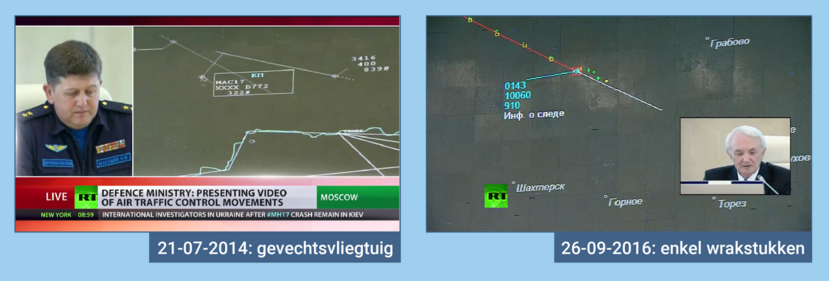
This time, a Russian radar specialist came to the conclusion that these reflections originated not from a combat aircraft but from the wreckage of flight MH17. Now the Russian primary radar images were being offered up as evidence that MH17 could not have been shot down from the alleged launch location near Pervomaiskyi. Furthermore, the Russian authorities provided false information about satellite photos of a purportedly Ukrainian Buk system on 17 and 18 July 2014. Satellite images from the European Space Agency (ESA) and Google Earth and meteorological investigation by the KNMI demonstrate that the Russian photographs could not have been taken on those dates. Russia is unable to provide the underlying digital image files for these satellite photos. When other, obvious evidential questions are put to the Russian Federation, it fails to answer them. We never received information, for example, about the whereabouts on 17 July 2014 of the Buk TELAR with the three-digit vehicle number that began with a 3 and ended with a 2, which was captured several times in images shot in the Russian Federation on 23, 24, and 25 June 2014. The Russian authorities do not wish to provide this information because, it alleged, the visual material of the TELAR from 17 and 18 July 2014 had been falsified. Leaving aside the fact that this is not a ground for refusing to provide evidence, it turns out that the accusations of manipulation simply do not hold water. Forensic image experts thoroughly investigated the Russian claims and refuted them one by one.
Great caution should therefore be exercised when assessing the Russian evidence. This Russian evidence is included in the case file, so that the court and the defence can study this alternative viewpoint. In this way we have assembled the most balanced case file possible.
2.3 Decisions regarding prosecution
That concludes our discussion of the overall course of the criminal investigation. During that investigation, the JIT countries consulted on where any future prosecution should take place. The preferred option was for the case to be heard by an international tribunal to be established by the UN Security Council. This option was blocked by the Russian Federation, a permanent member of the Council. It was then decided to conduct the prosecution in the Netherlands, as the country with the most victims, a country without any involvement in the conflict in eastern Ukraine and a country with considerable experience of prosecuting international crimes. This option was made possible by the provisions of article 5 of the Dutch Criminal Code.
2.3.1 Jurisdiction
Article 5 of the Criminal Code provides that Dutch criminal law applies to anyone outside the Netherlands who commits a serious offence against a Dutch national. The Netherlands therefore has jurisdiction over the downing of flight MH17 on the basis that a large number of the victims were Dutch nationals.
If, as is the case here, the offence concerns a single act resulting in multiple simultaneous fatalities, the offence as a whole is designated as the serious offence over which article 5 of the Criminal Code grants jurisdiction. That jurisdiction thus extends to the taking of the lives of all victims killed by means of the same act that killed the Dutch victims. In other words, that jurisdiction extends to the entire offence, i.e. the deliberate downing of an aircraft, causing everyone on board that aircraft to be killed, and thus the simultaneous murder of all the aircraft’s occupants. This means that the Netherlands has direct (original) jurisdiction over all the victims.
In order to forestall any doubt about the position of the non-Dutch victims, Ukraine was asked to transfer its own jurisdiction to the Netherlands. Although such a step was not necessary, it enables justice to be done, without further legal debate, for all the victims and next of kin, regardless of where in the world they were from.
In so far as the court – in contrast to the Public Prosecution Service – should conclude that the Netherlands has no direct (original) jurisdiction over certain offences in the indictment, the Netherlands therefore does in any event have derivative (subsidiary) jurisdiction over those offences.
2.3.2 Defendants
The decision to conduct the prosecution in the Netherlands means that the Dutch Public Prosecution Service makes any further decisions about who would be prosecuted and which offences they would be charged with. Back on the first day of these criminal proceedings, in March 2020, we explained how the Public Prosecution Service arrived at the decision to prosecute these four defendants – Girkin, Dubinskiy, Kharchenko and Pulatov. In the course of the extensive investigation, there were many persons of interest. Within that group of people against whom the investigation has produced sufficient evidence, we looked at the role played by the different suspects. Only those who played a primary role are eligible for prosecution in the Netherlands. Individuals who played a smaller role should not get off scot free, but can be prosecuted in Ukraine. And in several cases this has indeed happened. Subordinates of this kind have been prosecuted for their broader participation in the DPR as a terrorist organisation.
Among the DPR fighters, we see Girkin, Dubinskiy, Pulatov and Kharchenko as the leading players in the downing of flight MH17. Girkin and Dubinskiy occupied positions in the DPR’s top military leadership. Pulatov and Kharchenko were their direct subordinates. Together they are responsible for the deployment of the Buk TELAR used to shoot down flight MH17.
2.3.3 The indictment
The offence for which, according to the Public Prosecution Service, each of these four defendants is criminally liable, is that they are guilty of causing flight MH17 to crash, resulting in the deaths of the 298 occupants, and of the murder of those 298 occupants.
Their involvement was set out, in several variant forms, in the indictment. The Public Prosecution Service suspects each of the defendants of being guilty as functional perpetrators or functional co-perpetrators of these serious offences. In short, this means that although they did not press the button themselves, they are responsible for the downing of flight MH17 because together they requested and took over the Buk TELAR from the Russian Federation and deployed it in their armed struggle with the goal of shooting down an aircraft. They used the Buk TELAR as an instrument to serve their own military interest and in doing so hit flight MH17.
In the event that the court should see this differently, the alternative accusation is that the defendants committed the offences in the indictment in the capacity of co-perpetrators. In this variant, also, the defendants did not press the button themselves, but cooperated (with each other and) with others such that they can be designated co-perpetrators. In the further alternative, each of the defendants is charged with soliciting others to shoot down flight MH17. Finally, Girkin, Dubinskiy, Pulatov and Kharchenko are suspected in the final alternative of helping, in the capacity of accessories, to shoot down flight MH17.
2.3.4 The mistake scenario
When drawing up the indictment, the Public Prosecution Service explicitly took into account the possibility that the four defendants had actually intended to shoot down an aircraft of the Ukrainian armed forces. If this was their intention, it has no bearing on the fact that they are criminally liable from the Public Prosecution Service’s point of view. A targeting error also makes no difference with regard to the evidence that such offences were committed.
None of the offences in the indictment require intent as regards the civilian nature of the aircraft or those inside it. Article 168 of the Criminal Code prohibits deliberately causing any aircraft to crash (article 168 CC), regardless of the civilian or military status of that aircraft. The deaths of those inside are regarded as an aggravating consequence, not as a decisive part (or constitutive element), of the offence. Article 168 thus does not even require any intention to kill those inside the aircraft on the part of the perpetrator, let alone any intention to kill specific categories of people inside (civilian or military). It is also clear from the legislative history that the aviation offences in the Dutch Criminal Code apply to military aircraft as well as civil aviation. The crime of murder (article 289 of the Criminal Code) requires the intent to kill another person, but not a particular category of persons (civilian or military) or specific number of victims. This is why a person can just be convicted of murder in the Netherlands and many other countries if they shoot and kill a random passer-by instead of their intended victim. Anyone in the Netherlands who shoots down a combat aircraft of the Royal Netherlands Air Force can therefore be prosecuted under article 168 of the Criminal Code and for the pilot’s murder. And anyone in the Netherlands who intends to shoot down a combat aircraft of the Royal Netherlands Air Force but mistakenly downs a KLM commercial aircraft can expect the same prosecution. In short, in respect of the evidence for the offences in the indictment, it makes no difference whether the defendants intended to shoot down a military or a civilian aircraft.
2.3.5 Combatant immunity
When drawing up the indictment the Public Prosecution Service also took account of the fact that there was an armed conflict ongoing in Ukraine in July 2014. In July 2014 there was heavy fighting in eastern Ukraine between the Ukrainian armed forces and armed groups. In war different rules may apply than in peacetime: one of those rules is the doctrine of combatant immunity. This means that military personnel may carry out acts of war within the bounds of international humanitarian law and may not be prosecuted for those acts by another country. However, this rule applies only to regular military personnel who serve in international armed conflicts under the responsibility of a state and in a group that respects international humanitarian law. For other people who participate in an armed conflict, the normal rules of criminal law apply, and they can be punished for acts of violence they commit.
As we noted last year at the very start of this trial, war is not a licence for everyone to inflict violence on everyone else. That is not so in the Netherlands, and nor is it so in Ukraine or the Russian Federation. Over the centuries, all the states in the world have developed rules for warfare that are intended to limit the consequences of acts of war as much as possible. The basic principle is that armed conflicts are fought between military personnel and that civilians should not be caught up in them. Therefore, if civilians in Ukraine use violence against Dutch, Malaysian, Australian and Belgian nationals, this falls within the scope of the ordinary criminal laws of those countries. In such a case, those civilians have committed ordinary criminal offences, such as murder, or causing an aircraft to crash resulting in the deaths of the passengers and crew, regardless of whether they used a rifle or an advanced missile system, and regardless of whether the intended victims were civilians or military personnel. The same applies to armed fighters in Ukraine who say they are ordinary civilians; they too are covered by ordinary criminal law.
A licence – or immunity – for acts of war is granted only in exceptional cases. It is not done in chaotic and lawless situations, but only in relation to a use of force that is controlled and considered. ‘Controlled’ means the use of force is by regular military personnel who are recognisable as such, fighting under the responsibility of a state and in an organisational form that respects international humanitarian law. So it does not apply to groups fighting under their own flag, nor to groups who have no respect for international humanitarian law. Just like any other civilian, members of such groups are not permitted to commit acts of violence. Just like any other civilian, ordinary criminal law applies to them. The same goes for military personnel who pretend to be ordinary civilians, as this may provoke counter violence against real civilians. Therefore, military personnel who conceal their true status can also be punished for acts of violence, like anyone else. International humanitarian law imposes strict personal requirements in respect of combatant immunity. People who do not meet those requirements cannot simply take advantage of the combatant status of others whom they act alongside. Therefore, if a group of fighters commit acts of violence in association, it is possible that some of them can claim combatant immunity while others cannot. We would refer the court to the legal framework for combatant immunity, which we have previously discussed extensively during these proceedings.
The investigation did not show that in July 2014 the four defendants were regular military personnel operating on behalf of a state. Both the Russian Federation and the members of the DPR, including the defendants, have always denied that the DPR participated in the armed conflict in eastern Ukraine on behalf of the Russian Federation. The Russian government has repeatedly stated that the DPR fighters were not directed from the Russian Federation. The defendants have always stated that they participated voluntarily in the armed conflict in eastern Ukraine and that their group was not directed by the Russian Federation. Therefore, no command relationship that is evident to others existed, nor did the Russian Federation accept responsibility for the actions of the armed group to which all four defendants belonged. In fact, the Russian Federation even proposed taking over the prosecution of these four defendants. The absence of a command relationship evident to others alone means that the defendants cannot claim combatant immunity. Only regular military personnel who are recognisable as such and who fight under the responsibility of a state enjoy immunity for acts of war that result in death.
Furthermore, the investigation showed that the armed group to which the defendants belonged in the summer of 2014 did not respect international humanitarian law. The DPR committed systematic and large-scale violations of international humanitarian law in and after 2014. This concerned thousands of instances of looting, detention of civilians, torture, inhuman treatment and execution of civilians and prisoners of war, the placing of (prohibited) land mines, and many other offences in contravention of international humanitarian law. We have also discussed these factual investigation findings earlier in these proceedings.
The four defendants were not regular military personnel; they were self-proclaimed volunteers who took up arms and contributed to the chaos and lawlessness in eastern Ukraine. Dutch criminal law therefore applies to them, and they can be prosecuted for causing flight MH17 to crash, and for the murder of the aircraft's occupants, within the meaning of articles 168 and 289 of the Dutch Criminal Code.
2.3.6 Presumption of innocence
Every defendant has the right to a fair trial. That right is laid down in article 6 of the European Convention on Human Rights (ECHR). Paragraph 2 of that article states that everyone charged with a criminal offence shall be presumed innocent until proved guilty according to law. The defendants are therefore guilty of the offences with which they are charged only if the court finds that the evidence proves it. Until that time, the four defendants are innocent.
For this reason the Dutch Public Prosecution Service is generally cautious when it comes to publicly disclosing the identity of defendants. However, non-disclosure is not a given. Interpol, for example, publicises the names and photos of suspects who are wanted internationally, using so-called red notices. In other countries, too, and at international tribunals, the names and photos of defendants are disclosed before a court has given final and unappealable judgment regarding their guilt or innocence. In this case, we reached a similar decision. We did not come to this decision lightly. We did so only after carefully weighing the interests of the defendants against those of the next of kin and the public as a whole.
On the basis of article 2 of the European Convention on Human Rights, the Public Prosecution Service has an obligation to inform the victims’ families about the progress of the investigation and any decisions regarding prosecution. The families’ right to information about the investigation findings and prosecution decisions includes the right to information about the identity of the defendants. Since there were 298 victims in this case, and a much larger number of family members from all over the world, we are not able to share information about the investigation findings and prosecution decisions with the next of kin on an individual and confidential basis. In order to be able to reach all the family members at the same time, the JIT therefore had to make this information public. This course of action is also in accordance with the obligation under international law to inform to public as a whole about this case. The need for information in this case is especially important given the disinformation that is being spread, from the moment the disaster occurred on 17 July 2014, about the circumstances of the downing of MH17. The JIT can not, and nor does it wish to, withhold findings that could remove uncertainty among the next of kin and the wider public.
For this reason the JIT held various press conferences in which the next of kin and the wider public were periodically updated about the investigation’s findings. In 2016, the update concerned the weapon used and the location from which MH17 was shot down, and in 2018 the topic was the origin of that weapon. In 2019, the Dutch Public Prosecution Service announced its prosecution decisions. In view of the next of kin’s right to know the identity of these defendants and the inevitable public disclosure of their identity in connection with the international alert issued and the subsequent criminal proceedings, we provided their names and showed their photographs when we announced these decisions. When doing so the Public Prosecution Service stressed that the defendants were only suspected of committing these offences, that the court still needed to assess the evidence, and that the four defendants were innocent until proven otherwise. Because the defendants are still considered innocent, the accusations against them were formulated carefully and with the due caveats.
In our opening statement in these criminal proceedings, we reiterated that the court would ultimately have to weigh all the available evidence and on that basis give judgment on whether the defendants are guilty or not guilty. In this regard the task of the Dutch court differs from that in other legal systems, where the evidence is weighed by a jury. Where a lay jury might potentially be influenced by other people’s statements in the media, experienced professional judges are perfectly able to resist such a tendency, including in the opinion of the European Court of Human Rights.
3 Evidence
3.1 Introduction
We will now continue our assessment of the evidence. In order to have a firm grasp of this assessment, it is first necessary to explain why certain telephone numbers have been attributed to the four defendants and how we conclude that the conversations conducted over these lines are authentic. After that, we will reconstruct what happened before, during and shortly after the downing of MH17, with the help of intercepted conversations that were conducted via those telephone numbers and a large amount of other evidence.
3.2 Intercepted conversations
3.2.1 Introduction
Let us begin with the subject of who was using certain telephone numbers. Shortly after the downing of flight MH17, it emerged that the Ukrainian security service SBU was in possession of intercepted telephone conversations in which the downing of MH17 was discussed. Ever since the outbreak of the conflict in eastern Ukraine – i.e. long before the downing of MH17 – the SBU had been investigating the groups involved. For that reason the telephone lines belonging to a large number of members of the DPR were tapped, including lines that were found to have been used by the defendants.
These intercepted conversations were of great importance to the JIT investigation in establishing the roles of the individual defendants, since they give a sense of the dynamics at that particular time, pinpoint the location of the various participants and reveal who was doing what at key moments. It is equally important to know who the parties to these conversations were. For that reason, from the very start of the investigation a great deal of energy was devoted to the task of identifying these people. Because these identifications must be performed in a verifiable way and there can be no room for doubt, the JIT has always established the identity of the users of the telephone numbers itself. The conclusions of other parties about the identity of a given suspect were never adopted without additional verification and investigation by the JIT.
In July 2014 the four defendants were all using multiple phone numbers. They also made use of secure means of communication which could not be tapped. As a result, not all communication is available, though a great deal is. With respect to the numbers that are tapped, investigators used various methods to determine who was using which number. These findings have been included in various official reports which have been added to the case file. In a number of instances the JIT was aided in its identification efforts by the defendants themselves. For example, they may have said something in an interview or a statement that can be linked to information from an intercepted conversation. Or perhaps they simply acknowledged using a particular number or taking part in certain conversations.
Because of the importance of the intercepted conversations in determining the roles of the defendants and thus in proving the charges in the indictment, we will now discuss the findings that led us to conclude that certain telephone numbers were in use by the four defendants in July 2014. We will start with the number ending in -511, which is attributed to the defendant Pulatov. We will then discuss the methods used to identify Dubinskiy, Girkin and Kharchenko as the users of certain telephone numbers that emerged in the course of the investigation.
3.2.2 Telephone numbers used by the defendants
3.2.2.1 Pulatov uses the telephone number 380631212511
3.2.2.1.1 Introduction
One of the telephone numbers which emerged in the investigation and which is used when discussing the Buk TELAR is the number ending in -511. From the content of the conversations conducted on this number, we know that the user of the number is addressed as ‘Giurza’, ‘Oleg’ and ‘Oleg Yuldashevich’. On the basis of an examination of public sources and an online forum, we were able to establish that this user is the defendant Pulatov. For example, a forum user calling himself ‘Khalif’ is addressed by various other forum users as ‘Oleg’, ‘Oleg Yuldashevich’ and ‘Giurza’. This same forum user received birthday greetings on 24 July, shared images of the business cards of his Dutch defence lawyers, and stated that he had met and spoken to his lawyers. This ‘Khalif’ also shared screenshots on Glav of an online chat that took place on 19 June 2019 between the user of the OK account Oleg.Pulatov and a JIT investigator. On 28 October 2015, in a conversation with another forum user, he gave out his telephone number, namely the one ending in -511. Thus, it was already possible to determine on the basis of the JIT investigation that Pulatov was the user of this number.
3.2.2.1.2 Pulatov’s statement
During this trial Pulatov himself has confirmed that he was the user of this number. During the hearing of 28 September 2020 his defence counsel, speaking on his behalf, said that Pulatov had indeed conducted conversations using that number that were included in the case file:
'And yes, his voice can be heard in telephone intercepts. The interpretation of those conversations is, however, [...] an incredibly complex question. We need to study in greater depth the question of how we can clearly explain and substantiate it and our client’s view of it.'
Explaining this is exactly what Pulatov and his defence counsel did a little less than a month later, in a conversation that took place on 22 October 2020. In this conversation, which was filmed by his lawyers, who then provided the recording to the court, Pulatov explains how the intercepted conversations on the number -511 should be interpreted. Thus, he does not dispute that he participated in these conversations. On the contrary, in this video statement Pulatov says that the number ending in -511 was issued to him and that he used it throughout 2014 in the area controlled by the DPR (‘in the territory of the Republic of Donetsk’). In this video statement Pulatov also says that he ‘could always be reached on that number’.
In that same conversation with his defence counsel from October 2020, various intercepted conversations were played back to him, and for each one Pulatov explains the intention behind the conversation or the correct interpretation of specific words. In one case Pulatov explicitly confirms that it is his voice in the telephone conversation in question. He then explains that the questions he asks for confirmation purposes during the recorded conversation have to do with his hearing problems. In other cases he does not say explicitly that it is his voice on the recording, but it follows from his explanation of the conversation that he is one of the participants. For example, speaking about a conversation that took place on 16 July 2014, Pulatov says that he (‘I’) understood it to mean that the units would be relieved. At the hearing of 3 November 2020 his defence counsel confirmed on his behalf that Pulatov had taken part in the intercepted conversation he discussed:
'To be clear, our standpoint is not that our client did not take part in any of the conversations involving the number ending in -511. There are conversations in which he took part; he clarified these in his statement.' [underlining ours]
These are four conversations; four conversations that he clarified in his statement. One of them was not added to the case file; it is one of the recordings that were later provided to the defence for examination. Three other recordings were added to the case file. The first is a conversation about material and human losses due to air strikes and the need for long-distance artillery and reliable air defence systems. The second is a conversation about a meeting between Kharchenko, who is at the Furshet supermarket with ‘the toy’. The third is the conversation in which Kharchenko asks his interlocutor to contact the fighters with ‘the new little box’, who are not at the agreed place and have left one of their men behind. In October and November last year Pulatov acknowledged taking part in these conversations.
Several months later the defence suddenly claimed Pulatov could not say with any certainty if it was his voice that could be heard in these and other intercepted conversations contained in the case file. In light of what he said on video in October 2020 and what his counsel maintained at hearings in September and November of that year, this is not a credible claim. At that time his unambiguous position was that his voice could be heard in various intercepted conversations – a position that was recorded on video and that was shared with the court. A position on a matter we had been asking Pulatov about since the start of this trial. We have no reason to doubt Pulatov’s previous, well-considered position. This is why we start from what he in October 2020 on video and what was stated on his behalf at the hearings of September and November.
In that video statement of October 2020 Pulatov also says that on 17 July 2014 he was helping to transport a column of tanks to their locations and deploy them. This is consistent with the content of an intercepted conversation which was conducted with the defendant Dubinskiy on 17 July 2014 at 09:55:20 on the telephone number -511. In that conversation Dubinskiy calls the user of that number ‘Oleg’ and talks to this ‘Oleg’ about guarding the ‘Buk’ and the allocation of three ‘rhinos from Vostok’. Pulatov’s first name is Oleg. Furthermore, we know from photos, videos and social media posts that a column of three tanks from the Vostok battalion entered Snizhne on the morning of 17 July 2014, via the same route as the Buk TELAR convoy. This conversation about the Buk – which took place on the number at which Pulatov could, by his own admission, always be reached – not only includes his first name, but is also in keeping with his own statement about his involvement with tanks on 17 July 2014.
Finally, in response to the question of whether he received orders relating to a Buk, Pulatov said that he could remember that a Buk was discussed in one or more conversations. Later he mentioned several conversations in which the subject of a Buk came up. Admittedly, Pulatov does offer the proviso that this was for the purpose of spreading disinformation, but he acknowledges that he was involved in one or more conversations about a Buk.
In the case of only one conversation played to him by his lawyers does Pulatov specifically say that he was unsure if he was one of the participants because he does not recognise the voices. This concerns a conversation with DPR fighter Dmitri Tskhe, with call sign Koreets. While Pulatov does not acknowledge taking part in this conversation, he does not deny it either. The same goes for all the other intercepted conversations from June and July 2014 which involved his number ending in -511 and which were included in the case file or provided to his defence counsel for examination. Pulatov has not denied in taking part in any of them.
If we examine the content of the one conversation about which Pulatov claims that he does not recognise either of the voices as his own, it is actually more likely that he is one of the participants. As we stated at the hearing of 13 November 2020, this conversation, which took place at 19:01 on 17 July 2014 with Koreets, was part of a series of interrelated conversations on the same subject. Well over 15 minutes before this conversation Kharchenko and Pulatov talk about an aircraft being shot down. Kharchenko says that ‘we’ shot down a Sushka, while Pulatov adds that this Sushka took down ‘that Chinese plane’ just before. Pulatov then relays that information to Koreets (in the previously mentioned conversation) and then to Dubinskiy. Given that Pulatov does not dispute his participation in the conversations with Kharchenko and Dubinskiy, the Public Prosecution Service finds it implausible that someone else took Pulatov’s place and took part in the intervening conversation with Koreets. It is even more implausible if we consider that there were other conversations with Koreets involving this number, on which Pulatov could, by his own admission, always be reached. Pulatov was given the audio recordings of these conversations with Koreets (both those that were and those that were not added to the case file). He does not does dispute that he was the other participant. Why another person would take Pulatov’s phone to convey to one of Pulatov’s own contacts a message that Pulatov had conveyed multiple times himself is a mystery to us. Ultimately, it is not important for the evidence who took part in this one conversation with Koreets, because the uncontested conversations that Pulatov had with Kharchenko and Dubinskiy cover the same ground.
In short: it is our position that Pulatov himself has stated that he used the number ending in -511 in July 2014 and that he could always be reached on it during that month. He does not dispute that he took part in conversations in the file involving that number; indeed, in the case of a number of conversations he explicitly affirms that he did take part in them. Moreover, the content of these conversations has been confirmed by other sources of evidence.
3.2.2.1.3 Comparative voice analysis by the NFI
In order to be certain about this matter, the court ordered further expert investigation by the NFI into 14 incriminating conversations that were conducted on Pulatov’s telephone number ending in -511. This NFI analysed the voices of the participants in these conversations. In two instances, the call in question was too short to include it in the assessment. With regard to the other 12 recordings, the NFI has stated that according to the forensic findings it is more likely that they feature one and the same speaker than that they involve two or more speakers. In other words, this analysis by the NFI provides an objective indication that these conversations were all conducted by one and the same person. Pulatov has said that he took part in two of them. In the case of a third conversation, the one dealing with the three ‘Rhinos from Vostok’, the content is consistent with Pulatov’s statement and the use of his first name. On the basis of this NFI investigation and Pulatov’s own statement that he used the number ending in -511 and could always be reached on it, we draw the conclusion that Pulatov also took part in the other nine incriminating conversations.
3.2.2.1.4 Mobile phone mast data
The mobile phone mast data also indicates that this number was being used by Pulatov. The telephone associated with this number transmitted to the same masts as a second number which, according to the investigation, was also in use by Pulatov: +380 50 803 21 77. Up until 5 July 2014 both numbers were transmitting solely to masts in the vicinity of Kramatorsk. And on 16, 17 and 18 July 2014 both numbers were transmitting to masts in the same area. On 17 July 2014 the masts in questions were those in the vicinity of Donetsk, Makeevka, Torez, Snizhne, Pervomaiske, and Lysyche (to the south of Pervomaiske) and Rozsypne . In other words, throughout that day the telephones were always in the vicinity of each other.
And Pulatov was in the vicinity of those telephones. In his video statement of October 2020 Pulatov says that on 17 July 2014 he was in various places in the vicinity of Snizhne, including Marinovka. At 16:20 on the afternoon in question, around the time that MH17 was shot down, Pulatov heard the launch of a surface-to-air missile, from a distance, by his own estimate, of approximately 300m. According to Pulatov this happened at a location around two kilometres northwest of Marinovka. At the hearing of 1 November this year, the defence submitted a card on which Pulatov had noted where he was at 16:20: in a car between Pervomaiskyi and Stepanovka. Stepanovka and Marinovka are located a few kilometres away from each other as the crow flies, and south of Pervomaiske and Pervomaiskyi. It follows from the mobile phone mast data for the number -511, that at the time of the launch the telephone was in an area south of Pervomaiske. Moreover, this statement is consistent with the content of an intercepted conversation that took place at 19:52 on 17 July 2014, in which Pulatov says that he did not see the crash of flight MH17 because he was in Marinovka at the time. So, according to his own statement, Pulatov was in the same area as the telephone with the number ending in -511.
3.2.2.1.5 Conclusion
On the basis of what we have presented, the Public Prosecution Service believes it can be concluded beyond any doubt that in July 2014 the defendant Pulatov was using the telephone number ending in -511 and that he can be heard in the conversations that we will discuss further on in this closing speech.
3.2.2.2 Dubinskiy uses telephone number 380631213401
3.2.2.2.1 Introduction
Shortly after flight MH17 was shot down, an individual was speaking openly on the tapped number ending in -401, about the downing of an aircraft and a Buk system. It should therefore come as no surprise that investigators were keen to identify this user, who regularly introduced himself on the telephone as colonel Petrovskiy and Deputy Ministry of Defence. His interlocutors regularly addressed him as ‘Sergey Nikolaevich’, Khmury and on a few occasions ‘Dubinskiy’.
The interpreters at the JIT determined with the help of voice recognition that the person using the number -401 is the same person who used the numbers -582, - 147 and -773.
On the basis of information from the intercepted conversations, it proved fairly simple to identify this individual as the defendant Sergey Nikolayevich Dubinskiy.
3.2.2.2.2 Content of intercepted conversations and public sources
An online search for a combination of the names ‘Sergey’ and ‘Dubinskiy’ led to a profile page on the website ok.ru. This profile page belongs to Sergey Nikolaevich Dubinskiy Petrovski. The profile photo matches that of a man known to the Ukrainian authorities as ‘Khmury’. In 2014 an interview with a certain Major General Petrovsky was posted on the website Kazzura. This Major General introduced himself as ‘Major General Petrovsky Sergei Nikolayevich, call sign Khmury, born in 1962 in Donetsk Oblast’. In other words: all names used by or in reference to the user of the aforementioned telephone numbers, and a year and place of birth that match those of the defendant Dubinskiy.
Other findings confirm that it is indeed Dubinskiy’s voice in the intercepted conversations.
3.2.2.2.3 Statements by Dubinskiy
Dubinskiy himself has confirmed that he took part in various conversations using the number ending in -401. He confirmed this for the first time a few months after the disaster, in September 2014. At that time Dubinskiy was involved in negotiations with the Ukrainian authorities over the release of prisoners of war. His Ukrainian interlocutor is an acquaintance of Dubinskiy’s who was later examined as a witness. Their telephone conversations were recorded. In one of those conversations, which took place on 27 September 2014, the witness speaks with Dubinskiy about ‘the Boeing’, or flight MH17. In the months prior to that the Ukrainian authorities had released excerpts of three conversations about the Buk TELAR that were conducted via the phone number ending in -401. In response to the witness’s remark that he had been linked to the Boeing, Dubinskiy himself says the following:
When the toy was being moved around, got it. I mean the one, which was moved across the Republic’s area. Yes. It really features my voice. But it does not mean that someone was shooting down.
In this conversation Dubinskiy confirms he had taken part in previously released telephone conversations about the Buk via the number -401.
In November 2014 Dubinskiy gave an interview in which he spoke about a telephone conversation he had with DPR commander Khodakovsky shortly before the crash of MH17. According to Dubinskiy, Khodakovsky called him and offered him three or four tanks. A conversation matching that description did indeed take place via the number ending in -401. On 17 July, shortly after midnight (00:17), Khodakovsky called Dubinskiy and asked him how he could help. He offers both equipment and personnel, saying among other things that he has four tanks for Dubinskiy. In this same conversation Dubinskiy talks about the downing of two Sushkas by ‘his men’, about the casualties he suffered that day and about the fact that the Buk would arrive that night, after which all problems would be solved.
In 2020 Dubinskiy gave an interview to Bonanza Media which was posted on YouTube on 30 October 2020. In this interview Dubinskiy speaks about an intercepted conversation which he claims was misdated by the JIT as having occurred on 17 July 2014, rather than on 16 July 2014. Dubinskiy says that they also discussed this the last time. Shortly before that, the video refers to the Bonanza documentary MH17 – Call for Justice, for which Dubinskiy had apparently also spoken with the interviewer. In that documentary (which starts at 13:11 into the video), someone referred to as Dubinskiy responds to the question of whether it is correct that the telephone taps released by the SBU were from 17 July 2014. He replies that in any case the intercepted conversation with ‘Botsman’ in which he tells ‘Botsman’ that they shot down an SU-25 and that he is in Stepanovka at that moment did not occur on 17 July 2014 but on 16 July 2014. On the 17th, he says, he was already back in Donetsk. In response to the question of whether it is his voice on the recording he answers in the affirmative. The content of the conversation referred to by Dubinskiy almost perfectly matches the recorded conversation from 17:42 on 17 July 2014, which involved the telephone number ending in -401. Here Dubinskiy tells someone that he addresses as ‘Botsman’ that they have obtained a ‘Buk-M’ and just shot down a Sushka. In this conversation Dubinskiy also says that Marinovka had been captured the day before and that two Sushkas had been shot down that day as well. That last remark cannot be true if the conversation took place on 16 July 2014, as Dubinskiy would have us believe. Marinovka was captured not on 15 July 2014, but on 16 July. Furthermore, no Sushkas were shot down on 15 July, though two were on 16 July 2014. If Dubinskiy says in this conversation that both the capture of Marinovka and the downing of two Sushkas occurred on the day before, the conversation must have taken place on 17 July 2014 and not 16 July. This conclusion is also borne out by the analysis of the metadata of this recorded conversation and the historical telephone data from both participants in the conversation. All of this would thus suggest that this conversation took place not on 16 July 2014 but on 17 July. In brief: Dubinskiy has acknowledged that it is his voice on the recording of this conversation; the conversation did indeed take place on 17 July 2014; and there is nothing to suggest that the date was manipulated.
3.2.2.2.4 Voice recognition by Dubinskiy’s brother
The defendant Dubinskiy’s brother was also interviewed by the JIT. He was played a number of intercepted conversations and recognised his brother’s voice on them. He also provided information about Dubsinskiy’s personal circumstances, which come up in intercepted conversations and interviews. For example, he confirms the existence of a son, about whom and with whom Dubinskiy speaks in intercepted conversations, and he also recognises the latter’s voice in an intercepted conversation. He also said that he was familiar with two of his brother’s aliases: Khmury and General Petrovsky. He pointed out that the latter name was a reference to their mother’s maiden name.
3.2.2.2.5 Conclusion
In brief: on the basis of a comparison of the content of conversations with information from public sources, Dubinskiy’s own confirmation that he took part in various conversations and his brother’s recognition of Dubsinkiy’s voice, it can be concluded that Dubinskiy was the user of the telephone number ending in -401.
3.2.2.3 Girkin uses the telephone numbers +380 63 708 75 01 and +380 93 072 15 58
3.2.2.3.1 Introduction
During the period relevant to the investigation, Dubinskiy was in regular contact with the Ukrainian telephone numbers ending on -454 and -501. Calls to or from these numbers were generally answered by ‘Arman’ and ‘Dublior’ (also called ‘Sascha’), who seemed to be in charge of taking calls for an individual called ‘Pervyi(iy)’, ‘Igor Ivanovich’ and ‘comrade colonel’. From the content of the conversations it can be deduced that this ‘Pervyi’ is a high-ranking DPR fighter. Indeed, the word ‘Pervyi’ means ‘the first’. The voice of the person who is addressed in these conversations as ‘Pervyi’, ‘Igor Ivanovich’ and ‘comrade colonel’ is always the same, according to the interpreters of the JIT. The interpreters also recognise this individual’s voice in conversations that took place via the numbers -342, -558 and -182. They indicate that it is the same person on all these numbers, and that the person in question is called not only ‘Pervyi’, ‘Igor Ivanovich’ and ‘comrade colonel’, but also ‘Igor’, ‘Igorioha’ and ‘Ivanovich’. In one instance the voice can also be heard in a conversation that was conducted with the telephone number ending in -3401, which was used by Dubinskiy. In that case, too, this individual is introduced by Dubinskiy as ‘Pervyi’. Conversations involving this individual that were conducted via the numbers ending in -501 and -558 will return in our discussion of the evidence.
3.2.2.3.2 Content of intercepted conversations and public sources
We know from public sources and information uncovered by the investigation relating to the period around the downing of MH17 that a former Russian soldier going by the name of Igor Strelkov played a leading role in the armed conflict in eastern Ukraine. This Igor Strelkov was interviewed by slavyangrad.org on 22 January 2015. The JIT interpreters recognised the voice of the interviewee (Igor Strelkov) as belonging to the individual who can also be heard in the intercepted conversations, where he is addressed as ‘Pervyi’, ‘Igor Ivanovich’ and ‘comrade colonel’.
The investigation team then searched online for the name ‘Igor Strelkov’. This search revealed that the name ‘Igor Strelkov’ was being used by Igor Vsevolodovich Girkin (born in Moscow on 17 December 1970), who previously was employed by the Russian armed forces and the Russian security service FSB and who, by his own account, had attained the rank of colonel.
3.2.2.3.3 Pulatov’s statement
Pulatov’s video statement is also relevant to the identification of Girkin as the user of the numbers ending in -501 and -558. Pulatov states that from May 2014 he was under the direct command of Girkin and Dubinksiy, and that he reported to just two people: the commander of the militia fighters, ‘Strelkov’, and the head of the intelligence section, ‘Khmury’. Pulatov thus confirmed not only the chain of command that had been pieced together from the intercepted conversations but also the fact that Girkin and Strelkov are indeed the same person.
3.2.2.3.4 Remarks by Girkin
Finally, Girkin has made remarks that confirm he was the individual who used the numbers ending in -501 and -558.
For example, in the witness statement Girkin made on 6 February 2015 to the Russian law enforcement authorities, he confirms that ‘(Igor) Strelkov’ was his nickname or call sign while taking part in the fighting in Donbass. He states that in his capacity as Minister of Defence of the People’s Republic of Donetsk he used the alias ‘Igor Strelkov’ and that he still uses it as head of the social movement ‘Novorossiya’. Girkin also speaks about his duties, which, in the period relevant to the investigation, basically involved coordinating the activities of the people’s army and leading the units of that army. He mentions activities that are consistent with those of the person, who used the telephone numbers referred to earlier.
It follows from two posts by Girkin to his VK account that he was using the telephone numbers ending in -501 and -558. The first message was posted shortly after the press conference held by the JIT on 19 June 2019, in which it was announced that he would be prosecuted for the downing of MH17. At that press conference, two intercepted conversations from 8 June 2014 were played, featuring Girkin and Aksyonov, the Russian-appointed leader of occupied Crimea. In one of these conversations involving the number ending -558, a person named ‘Igor’ calls. This ‘Igor’ says to Aksyonov that he needs ‘decent anti-aircraft artillery’ with ‘a trained crew’. After the release of this conversation at the press conference of 19 June 2019, Girkin wrote on VK that same day:
'Aren’t the Dutch great!... I listened to the audio recordings of my so-called ‘revelatory’ conversations ‘on the matter in question’, and I still don’t understand what they have to do with that Boeing. True, I asked Aksenov for help, tanks, anti-tank artillery and aircraft defence systems. True, I called him from Donetsk (where else?). So what? Have I ever made a secret of that? Of the fact that I was in touch with Aksenov or that I’d requested assistance – including military assistance – from the RF? No. I asked for help but didn’t get it. So what’s the issue?'
Girkin explains what he discussed with Aksyonov and thus acknowledges that he is the person addressed as ‘Igor’ who was using the number -558.
Girkin does so again in a subsequent VK post, from 15 November 2019. He posted this message the day after the JIT issued an appeal for witnesses in which it released a telephone conversation of 13 August 2014 between Borodai and Girkin. In this conversation the telephone with the number ending -501 is passed to a person who is addressed as ‘Ivanovich’. This ‘Ivanovich’ tells Borodai that he is going back to ‘the staff’. He also says that Borodai must return to the staff. In his witness statement of 6 February 2015 Girkin states that he held the position of minister of Defence up until 12 August 2014 and that he returned to the Russian Federation on 15 August 2014. In its appeal for witnesses the JIT asked who gave orders to Girkin and Borodai in the summer of 2014 and what the role of ‘the staff’ was. In response to this, Girkin wrote on his VK page:
‘To be brief: a Dutch investigation team has made ‘a revelation’ – the team has learned that the defendant Girkin spoke on the telephone with Borodai on 13 August 2014.’
Girkin then provided a full transcript of that intercepted conversation on his VK account, repeated the questions asked by the JIT and answered them as follows:
‘Non-esteemed Dutch morons! Try to get it straight in your heads (I understand – it’s difficult, but try anyway): in Donetsk I had my “own” Staff. My own. Which was led by me personally. With which I led the fighting of the DNR fighters against the Ukro punitive forces.’
Girkin thus explains how the telephone conversation of 13 August 2014 should be interpreted and implicitly acknowledges that he is the person calling as ‘Ivanovich’ from the number ending in -501. In an interview of 15 March 2020 he returns to the subject of this conversation (which he mistakenly dates as 12, rather than 13 August 2014) and other intercepted conversations released by the JIT that were attributed to him. At that point Girkin says:
‘And as far as the so-called evidence that has been released – certain discussions involving me that were released by the Dutch – by the way I admit that I said that, I can even remember those moments; for example, my conversation with Boroday on 12 August 2014; but I beg your pardon, nobody says anything there about a Boeing or Buks, nothing even remotely related to those subjects is said, even indirectly. It is therefore laughable to consider these discussions as evidence.’
So Girkin admits that he had these conversations.
3.2.2.3.5 Conclusion
This establishes that defendant Girkin is the one who was using the numbers ending in -501 and -558 and who was addressed as ‘Strelkov’, ‘Pervyi’, ‘Igor Ivanovich’ and ‘comrade colonel’.
3.2.2.4 Kharchenko uses the telephone numbers +380 66 082 75 18 and +380 95 016 51 97
3.2.2.4.1 Introduction
We will conclude by discussing Kharchenko. When investigators studied the intercepted conversations, the user of the numbers ending on -518 and -197 fairly quickly emerged as a person of interest. For example at 18:44 on 17 July 2014 Pulatov spoke to the user of the number ending in -518 about ‘our Buk’ and the downing of a ‘Chinese passenger aircraft’. On 17 July 2014 Dubinskiy was also in frequent contact with this number and the one ending in -197.
In the course of the investigation interpreters working for the JIT determined that the individual using the numbers ending in -518 and -197 was the same person. It was also established that this person was mainly addressed in these conversations as ‘Krot’ or ‘Lyonya’.
3.2.2.4.2 Content of intercepted conversations and public sources
The content of the intercepted conversations gave cause to conduct further investigation into this individual and these aliases. In both Ukrainian and Russian, ‘Lyonya’ is a common nickname for the given name Leonid. This name also comes up in a number of intercepted conversations, in combination with the name Vladimirovich. For example, in a conversation of 18 June 2014, the user introduces himself as the military commander of Konstantinovka. When asked what his name is, he replies: ‘Leonid Vladimirovich’. On 11 July 2014 the user of the number -518 is asked to provide his personal information. The user then replies as follows: ‘Kharchenko Leonid Vladimirovich’ and the year ‘1972’.
With that, the identification of the user of the number -518 is almost complete. Further investigation of the name Leonid Vladimirovich Kharchenko and the year 1972 conclusively identifies this user as the defendant Kharchenko.
From a report by the SBU, we know that an individual with the name Leonid Volodymyrovych Kharchenko, born on 10 January 1972, applied for a replacement passport. A photograph was enclosed with the application. A mortgage registration was also found under this same name and corresponding passport number, for an address in Konstantinovka in eastern Ukraine. This same address also appeared in certain Ukrainian justice documents – i.e. the criminal record – relating to Leonid Volodymyrovych Kharchenko, born on 10 January 972. The passport photo in the criminal record matches that of the application for the replacement passport.
3.2.2.4.3 Pulatov’s statement
In his video statement Pulatov says the following about Kharchenko:
‘It was at that time, in late August, early September, that the People’s Defence Force of the city of Konstantinovka was merged with the intelligence staff, the Konstantinovka intelligence battalion as it was known, under the command of Kharchenko, call sign Krot. And that Konstantinovka People’s Defence Force became the second special unit within the intelligence service.’
In reply to the question from his lawyers regarding his hierarchical relationship with his fellow defendants Girkin, Dubinskiy and Kharchenko, Pulatov says:
‘In the period from May 2014, Girkin and Dubinksiy were my direct superiors, […] while Krot (Kharchenko) and the Konstantinovka People’s Defence Force were one of the units we worked with from time to time until August. Starting in September this unit became part of the Intelligence Staff, and they were placed under my command.’
The statement by Pulatov about Kharchenko’s call sign and role is therefore consistent with the content of the intercepted conversations that were conducted via the telephone numbers ending in -518 and -197.
3.2.2.4.4 Kharchenko’s statements
Then there is an interview with Kharchenko from 11 April 2015. In it he introduces himself as Lt. Col. Leonid Vladimirovich Kharchenko, ‘Chief of the Department Two of the Republican Guard Intelligence’. Chief of the second unit of the Intelligence Staff, therefore, exactly as indicated by Pulatov. A reporting officer has stated that it is highly probable that the voice of the man on the video is that of the man who took part in conversations using the number ending in -518. In response to the interviewer’s question of how the intelligence service is organised, Kharchenko replies that it all started with the arrival of Sergey Nicolaevich Petrovskyi, who set up this unit of the DPR. As we previously discussed, this is one of the defendant Dubinskiy’s aliases. This also dovetails perfectly with the way the mutual relations emerge from the conversations conducted by the user of the numbers ending in -518 and -197.
On 20 December 2019 another interview with Kharchenko was published. In it the interviewer says that DPR fighters were genuinely surprised to hear and recognise their own voices in intercepted conversations. To that Kharchenko says:
‘As far as I know, it was an MTS network, a Ukrainian network, which was tapped by the SBU. And they can randomly edit in any sentence I might have uttered, up to now. Even making me say that I killed by own mother.’
Here it would seem that Kharchenko is referring to the previous publication of intercepted telephone conversations by the SBU and the JIT and to implicitly confirm that that is his voice on them. One of the published conversations, which involved the number ending in -518, deals with ‘our Buk’. Kharchenko does not say which conversations would have been edited and which out-of-context sentences they would have been assembled from.
3.2.2.4.5 Conclusion
On the basis of all these findings it can be concluded that Kharchenko was the user of the telephone lines with the numbers ending in -518 and -197. All the defendants have therefore now been identified as users of the telephone numbers that are relevant to the investigation into the downing of MH17.
3.2.3 Authenticity of the intercepted conversations
In addition to concluding that the abovementioned telephone numbers were used by the defendants, we also take the position that the conversations conducted on those numbers are authentic.
On the basis of the defendants’ statements that we have just discussed, there are no grounds to doubt the authenticity of the intercepted conversations. On the contrary, Girkin and Pulatov have themselves confirmed the content of several of those conversations. Furthermore, the general suggestions made by Dubinskiy, Kharchenko and Pulatov that the intercepted conversations could have been edited are not concrete indications of manipulation, even though Pulatov and Dubinskiy in any case may reasonably be expected to offer concrete grounds for these vague accusations. After all, since last September, Pulatov has had the audio recordings and metadata for all the conversations that took place in June and July 2014 on his number. Despite that, Pulatov has not identified a single specific conversation that he believes to have been edited. Dubinskiy has said that he studied the recordings of intercepted conversations that were released before and during this trial. His suggestion of manipulation goes no further than his claim that one of the conversations – which he acknowledges did take place – had occurred on a different date. As we have already discussed, this cannot be the case. In short: the various remarks by the defendants offer no grounds whatsoever to doubt the authenticity of the intercepted conversations.
Standing in contrast to the unfounded assertions by the defendants is the extensive investigation conducted into the authenticity of the conversations. We discussed this previously during the proceedings on the merits in June of this year and in our presentation on the investigation in June last year. As we said on those occasions:
- information was requested about the location of mobile phone masts, and network measurements were taken;
- in a random survey telecom data/metadata was compared and cross-checked in various ways;
- data from Ukrainian providers was compared with data obtained for this purpose from foreign (non-Ukrainian) providers;
- it has been established in various ways that other participants in intercepted conversations have recognised their own voices and that other participants have confirmed the content of those conversations, thus also confirming that the conversations did indeed take place; and
- public sources were examined to ascertain whether events discussed in intercepted conversations had actually taken place.
This extensive investigation yielded no indications whatsoever of manipulation; quite the contrary, it only served to confirm the authenticity of the intercepted conversations.
At the behest of the court, the audio files of 14 incriminating conversations were subjected to further technical forensic analysis. These were conversations conducted on the line used by Pulatov (the number ending in -511). Six of the 14 conversations took place on the line used by Dubinskiy (the number ending in -401). This analysis was performed by experts from the Forensic Science Centre of Lithuania. According to these experts the audio files contain no trace of editing. On the basis of various examinations the experts concluded that the recorded conversations proceeded in a logical manner and the integrity of the dialogue was not compromised. On the basis of a (spectral) analysis of the recording, the experts concluded that the frequency band was in line with that of telephone networks, including during pauses in the conversation. In addition, in every recording the acoustic background environment remains constant throughout the course of the conversation, and in the metadata of the files, the experts found no traces of editing. Thus, this expert investigation found no indication whatsoever of manipulation either.
In short: the conversations the defendants took part in via phone lines they used are authentic. Later on, we will discuss those conversations in conjunction with other evidence. This will show once again the extent to which the content of those conversations is consistent with actual events, the occurrence of which we have been able to substantiate with other evidence.
3.3 Context
3.3.1 Introduction
We will now resume discussing the evidence, and we will start by considering the context in which the defendants’ actions took place.
The Public Prosecution Service has already spoken at length about this: about the armed conflict, the division of roles within the defendants’ armed group that calls itself the DPR, the developments in the fighting and the DPR’s need for air defence in the period leading up to 17 July 2014.
Today we will take a closer look at the context in which MH17 was downed and explain the nature of the defendants’ cooperation at the time of the downing. This is important for assessing the evidence of the intent of the defendants and their cooperation. We will summarise the most important information in chronological order and discuss the defendants’ armed group in more detail. It will become clear that in the period leading up to 17 July 2014 the defendants formed a close-knit, cooperating offender group that focused, inter alia, on downing aircraft, and that they had a shared interest in the deployment of a Buk TELAR,
3.3.2 Developments prior to July 2014
To fully understand the situation on and around 17 July 2014, it is important to know about the period leading up to that time. We will therefore first describe the developments in eastern Ukraine in the spring of 2014. That is when the DPR and LPR groups took up arms.
3.3.2.1 April 2014: establishment of the DPR
In early 2014 there is unrest in Ukraine. Geopolitical developments have led to protests in the capital, Kyiv, the resignation of the Ukrainian government and the annexation of Crimea by the Russian Federation. In the spring of 2014, violent confrontations involving pro-Russian groups occur in several places in Ukraine.
On 7 April 2014 a group of armed persons occupies the regional government building in the city of Donetsk in eastern Ukraine. They proclaim the establishment of the Donetsk People’s Republic, or DPR. This is the armed group to which the defendants belong. Five days later, on 12 April, armed men occupy government buildings in the city of Slavyansk. You can see the capture of the cities of Donetsk and Slavyansk here on the map.
In Luhansk, the oblast (province) east of Donetsk, similar developments take place in this period. On 27 April the Luhansk People’s Republic (LPR) is proclaimed in the capital, Luhansk, seen here on the map.
In the months that follow, the LPR will occupy the area to the east, up to the Russian border. In July 2014 the DPR and the LPR are working together in the fight against the Ukrainian government, but they constitute two separate groups.
The defendants all join the DPR in about the same period and start to cooperate with each other within this group. We will now discuss this cooperation in further detail.
3.3.2.1.1 Role of the defendants
The defendant Girkin arrives in Slavyansk from Crimea on 12 April 2014. That is the day the city is captured. In an interview in November 2014, Girkin says that Aksyonov, the leader of annexed Crimea appointed by Russia, has asked him to ‘focus on the northern territories’ and appointed Girkin as his ‘adviser on these issues’. When Girkin says ‘northern territories’ he is referring to the Donbas. This is the area the separatists will later gain control over. In another interview in 2017 Girkin says he ‘went as a volunteer’. When asked, ‘So you proposed it and Aksyonov supported you?’, Girkin says that he was acting on his own initiative and that he ‘was appointed by no one and sent by no one’. In the months after his arrival in eastern Ukraine, Girkin continues to maintain contact with Aksyonov, for instance on 8 June when requesting ‘decent anti-aircraft defence manned by trained personnel’. From the moment he arrives in Slavyansk, the defendant Girkin leads DPR fighters in that area. On 26 April 2014, Girkin gives a press conference in which he is introduced as ‘commander of the Donbas People’s Militia’. In May 2014, the DPR leadership appoints Girkin ‘Minister of Defence’. During his witness examination, Girkin says: ‘In the period from 12 April 2014 to 15 August 2014 I was on Ukrainian territory, where from 16 May to 12 August 2014 I held the post of Minister of Defence and Commander-in-Chief of the people’s army of the Donetsk People’s Republic.’ Girkin is therefore given various titles within his armed group. This shows that he is seen as one of the most senior leaders of the DPR and that he is in charge of the armed combat. Girkin himself says in an interview in November 2014 that in eastern Ukraine he was ‘given the opportunity to command the entire theatre of operations’ and in doing so ‘continually took part in the fighting’. In his witness examination he says that his duties included ‘coordinating the activities of units of the people’s army and directing combat activities’. It is clear from the case file that in this period Girkin is not just in charge on paper, but actually directs the separatists in Donetsk in the armed conflict.
The defendant Dubinskiy also joins the DPR in this period of its inception. In an interview, Dubinskiy says that in April 2014 he was in contact by phone with the defendant Girkin, whom he knows from when they did their military service together in Chechnya, and that he then went to join him in Slavyansk. There, Dubinskiy is given the position of ‘deputy army commander of the Donetsk People’s Republic’ under Girkin.
The defendant Pulatov says in his video statement of February 2020 that he joined the DPR on 2 May 2014 voluntarily and of his own accord. Pulatov states that in view of his military experience he is first given command of two units of 30 personnel. By his own account he is then attached to the intelligence staff and given command of around 1,150 personnel. Pulatov also states: ‘In the period from May 2014 Girkin and Dubinskiy were my immediate superiors’.
In an interview the defendant Kharchenko refers to the formation of the intelligence unit. According to Kharchenko ‘their’ unit was formed in May 2014. On 18 June 2014 Kharchenko says in an intercepted conversation that he is the commander of Konstantinovka. This is a city just north of Donetsk. It is not clear from the case file exactly on what date Kharchenko joined the DPR, but it has to have been some time in May or June 2014.
The defendants work together within the DPR. Girkin soon becomes leader of the DPR fighters. The co-defendants receive orders from Girkin, and in turn command other fighters. They create a structure in which certain fighters are given specific tasks and responsibilities that appear to be derived from the task areas of regular army units. It is not a formal military structure and sometimes there are misunderstandings about who has what task and when separatists operate autonomously.
It is in this context that the DPR takes up arms against the Ukrainian government. In the months that follow, the DPR becomes largely responsible for the outbreak and continuation of the armed conflict in eastern Ukraine, and the ensuing violence. This situation causes far-reaching social disruption and danger to civilian and military personnel. Moreover, the case file contains indications that serious violations of international humanitarian law are taking place by the DPR, systematically and up to the highest level.
3.3.2.1.2 Task areas of logistics and air defence
As we just discussed, certain fighters in the DPR are given specific tasks and responsibilities that appear to be derived from the task areas of regular army units. Two task areas are of particular importance and so we will discuss them briefly: logistics and air defence.
3.3.2.1.3 Logistics
The investigation has shown that during the conflict in eastern Ukraine military materiel is brought in from the Russian Federation for the purpose of the fighting engaged in by the DPR and LPR. The DPR uses a ‘logistics unit’ for this. This unit comprises, among others, a separatist named Andrey Chernykh, also called ‘Bibliothekar’. It is apparent from the telecom analysis that in July 2014 the fighter named Vlokh is also regularly involved in the transport of military materiel from the Russian border area to the vicinity of Donetsk. Vlokh and Chernykh work together during that period. On 17 July the logistics unit plays a role in the transportation to the launch site of the Buk TELAR that will down MH17 and we will therefore come back to this unit later in this closing speech.
3.3.2.1.4 Air defence
Several sources in the case file point to another specific task area within the DPR, i.e. that of air defence. For instance, in his witness statement Girkin speaks about ‘the air defence of the people’s militia of the Donetsk People’s Republic’. Girkin also states that around 15 June 2014 ‘the head of air defence at the Slavyansk garrison’ reported to him about a Ukrainian civilian aircraft. According to Girkin, a month later, on 17 July, a fighter with call sign Kep reported to him about ‘the hitting by the air defence of one of the two Su-25 aircraft of the Ukrainian air force (...) north of the town of Snezhnoye’. Apparently the DPR under Girkin’s command also had fighters in the area near Snizhne who were responsible for air defence. In addition it is apparent from intercepted conversations that the DPR fighter named Tskhe, with call sign Koreets, also plays a role in these air defence operations. In an intercepted conversation of 15 July 2014 at 16:29 between the defendants Dubinskiy and Kharchenko, he is referred to as (belonging to) the air defence. Pulatov conducts several, intercepted, conversations with Koreets in which he gives Koreets various orders concerning the deployment of his air defence unit. Another DPR fighter involved in air defence is Tsemakh. During his witness examination, Tsemakh says in reply to the question of what he was doing in the early summer of 2014: ‘Since 26 of June, I have been asked to handle the anti-air defence of the town of Snizhne’. In a 2019 post in VK, Girkin describes him as ‘commander of the air defence unit in the city of Snizhne in July-August 2014’. In the same post, Girkin says that he knows Tsemakh personally and ‘has spoken to him, as well as other local commanders, a few times when he was in Snizhne to coordinate the operations (...)’.
It is clear from many other intercepted conversations in which DPR fighters discuss the threat of aircraft and the availability of air defence weapons that the DPR’s ‘air defence’ in fact involves ‘shooting down aircraft’. In the summer of 2014 the airspace is kept under observation by the DPR fighters. Sightings of aircraft are passed on to the ‘intelligence department’ led by the defendants.
The case file also shows that in the summer of 2014 the DPR has various weapons at its disposal that serve (only) to down aircraft and that those weapons are indeed used. The defendant Girkin has spoken about this on several occasions. We will come back to the actual targeting of aircraft with these weapons later today.
3.3.2.2 June 2014: DPR fighting and ‘ceasefire’
In June 2014 the DPR advances southwards through Donetsk oblast. On 8 June the town of Snizhne is occupied. Trenches are dug and snipers and fighters with portable air defence systems are positioned on the rooftops. From then on Snizhne serves as the southern base of operations for the DPR. You can see the capture of Snizhne here on the map.
In early June 2014 the DPR is fighting the Ukrainian armed forces on two fronts: on the northwestern front, in and around the cities of Slavyansk and Kramatorsk, and on the southern front, towards the Russian border, near Snizhne and the Saur-Mogila hill. You can see it here.
At the beginning of June, Slavyansk, the place where at that moment Girkin has his headquarters, is under heavy fire. On June 8 Girkin asks, via the aforementioned Aksyonov, for military support from the Russian Federation. Girkin says they need ‘decent anti-aircraft defence manned by trained personnel’. In a subsequent intercepted conversation, Aksyonov confirms Girkin’s request.
On 20 June Ukrainian President Poroshenko announces a – unilateral – ceasefire, entailing that the Ukrainian forces will not engage in any combat unless they are attacked. On 23 June Alexander Borodai, the self-proclaimed prime minister of the DPR, states that the separatists will abide by the ceasefire of 20 June. Despite this ceasefire there is still fighting on going near Saur-Mogila on 23 June. And on 24 June a Ukrainian helicopter is downed by an anti-aircraft missile, killing nine people. On 30 June the ceasefire ends and the fighting resumes at full intensity.
3.3.3 The situation in July 2014
We will now discuss the situation in July 2014, the period in which MH17 was downed. After a relatively calm period, with the ceasefire we just discussed, in early July there is heavy fighting around Slavyansk, which at the time is still the defendant Girkin’s headquarters. After heavy fighting, on 5 July both Slavyansk and Kramatorsk fall and are recaptured by the Ukrainian armed forces. The DPR fighters retreat southwards. Girkin says of this period that Slavyansk had to be given up due to a lack of support from the Russian Federation.
3.3.3.1 Cooperation between the defendants: reconnaissance battalion in Donetsk
At that point, in July 2014, the DPR consists of various units, each with more or less its own territory, but with a clear hierarchy among the fighters. Commanders are responsible for certain areas or tasks, and in that context they direct other fighters. In turn the commanders report to persons higher up in the chain of command. In July 2014, in the area from which MH17 will be downed, the defendants are those ‘higher ups’.
After his departure from Slavyansk, Girkin bases himself in the city of Donetsk, where he continues in his leadership role. The units are then reorganised and divided into ‘three battalions and a reconnaissance battalion’, says Girkin in an interview. In this ‘reconnaissance battalion’, which has its headquarters in Donetsk, Dubinskiy is Girkin’s deputy and Pulatov and Kharchenko fall under them. For their part, Pulatov and Kharchenko direct other DPR commanders. In July 2014 the defendants are in charge in the area from which MH17 was downed.
The hierarchy among the defendants does not mean that orders from Girkin always end up with Kharchenko via Dubinskiy and Pulatov . Within the cooperation as it existed in July 2014, Pulatov for example receives orders not only from Dubinskiy but from Girkin as well. And in that period Kharchenko takes orders not just from Pulatov but directly from Girkin and Dubinskiy as well.
In evidentiary terms the hierarchy of the armed group of the defendants is relevant, but it is not a decisive factor. Much more important is the nature and intensity of the actual cooperation between the four defendants which was focused on the downing of an aircraft with ‘their’ Buk TELAR. We will return to this point later.
3.3.3.2 Area control and DPR transport routes
As discussed, in July the Ukrainian armed forces regain territory. In mid-July the area controlled by the DPR and LPR looks like this.
The DPR controls the western area marked here, between Donetsk and Snizhne; the LPR controls the eastern area, partly bordering the Russian Federation. This is important for the separatists because materiel is brought in from the Russian Federation for the purpose of the fighting. The border crossings that are used the most in July are those near the Ukrainian towns of Severny and Izavaryne. These two border posts in Luhansk oblast can be seen on the right of the map.
Heavy military materiel regularly comes into the area from the Russian Federation via these border posts. These transports occur frequently in July 2014, and they are bound for both the LPR and the DPR.
The Buk TELAR that will down MH17 is probably delivered to the separatists from the border crossing at Severny. In the days prior to the arrival of this weapon, other materiel transports also take place via this border crossing. For instance, another air defence weapon is delivered in the night of 13 to 14 July. According to intercepted conversations, it is intended to keep the air above the area under LPR control ‘clean’, but it subsequently malfunctions and can no longer be used. To be absolutely clear: this is not the Buk TELAR that ends up with the DPR and is used to down MH17. A day later, in the early morning of 15 July, yet another convoy passes the border post at Severny. This convoy includes four tanks, three artillery vehicles, an armoured personnel carrier (BTR) and a white truck with a white trailer. This convoy is escorted by the logistics unit of the DPR, of which the aforementioned Vlokh and Chernykh are part. They are directed by the defendants Girkin and Dubinskiy. Two days later, in the night of 16 to 17 July, the Buk TELAR that will down MH17 is delivered by means of the same form of cooperation and via the same route.
There are therefore standard routes for the delivery of military materiel. As the separatists are dependent on supply from the Russian Federation, control of the border area is of great importance to them. Control of the southern part of the DPR area, which besides Donetsk comprises the towns to its southeast, such as Snizhne, Pervomaiske, Dmitrovka, Stepanovka, Marinovka and Tarany, is also of strategic importance. We will now discuss in more detail the offensive conducted in that direction by the DPR in July 2014.
3.3.3.3 The DPR offensive on the southern front
As has been said, in early July there is heavy fighting on the northern front. On the southern front the focus is on fighting around the Saur-Mogila hill, which can be seen here on the map.
As it is the highest point in the region, the hill is of great strategic importance. Saur-Mogila remains in the hands of the DPR throughout the whole month of July, but the separatists’ positions frequently come under attack from artillery fire and air strikes.
From 6 July 2014 the DPR starts preparations for a southerly offensive. A breakthrough would separate the Ukrainian troops on either side of a corridor to the Russian Federation from each other, and thus weaken them. Moreover, the DPR would gain control of the southern area bordering Russia. This intended ‘corridor’ from DPR-held territory to Russian territory is indeed referred to by that word by DPR fighters in intercepted communications.
This operation towards the south further increases the intensity of the fighting. The Ukrainian armed forces want to prevent the separatists from breaking through to the Russian border and conduct numerous air strikes. The DPR suffers heavy losses and deploys anti-aircraft guns. The separatists succeed in downing several military aircraft. In this offensive, which is still ongoing in the afternoon of 17 July 2014, the defendants play an important role, including with regard to the deployed air defence. We will now discuss in greater detail the defendants’ role during the offensive.
3.3.3.3.1 Offensive in southerly direction from 6 July 2014
It is clear from intercepted conversations and telecom data from 6 July 2014 that Dubinskiy is with Girkin in Donetsk that afternoon at 13:30. A few hours later, just after 17:00, Pulatov also comes to Donetsk and joins Dubinskiy. In an intercepted conversation made at 17:13 Dubinskiy and Pulatov can be heard discussing the fact that they have been ordered to conduct preliminary reconnaissance south of Snizhne towards the border with the Russian Federation. Pulatov then leaves in that direction. The next morning Pulatov returns to Donetsk to report his findings, as is apparent from the location of relevant phone masts and an intercepted conversation.
Three days later, at a press conference where he is announced by Borodai as the ‘commander of the armed forces of the DPR’, Girkin points out the location of the frontline at that time: through Shakhtyorsk, Torez and Snizhne. According to Girkin, the heaviest fighting on the southern frontline is concentrated near Saur-Mogila and Stepanovka, where prolonged fighting and artillery fire from both sides is ongoing.
From 14 July heavy fighting takes place in this area between the Ukrainian troops and the DPR. On 14 July an air strike is carried out on Dmitrovka by the Ukrainian air force. In the night of 14 to 15 July the separatists attack checkpoints near Stepanovka and thereafter the village is captured. It is apparent from intercepted conversations that in the afternoon of 15 July, Pulatov receives an order from Dubinskiy and then makes plans with Kharchenko to leave from Donetsk. That evening around half past twelve (p.m.) Kharchenko phones Pulatov and tells him he is in Snizhne. Kharchenko asks whether he should go to Prapor, the local DPR commander. Pulatov confirms this and orders Kharchenko to tell Prapor that they are the first to arrive and that the main force is behind. It emerges from an intercepted conversation of the same evening between two commanders of the Oplot battalion that Pulatov has been designated as the person who coordinates all DPR troop movements (‘a coordinator of all forces that have been dragged and are being dragged there’). We will speak later about the fact that Pulatov retains that leadership role in the days that follow and that Kharchenko and his fellow fighters form the vanguard of the southwards offensive from Snizhne.
3.3.3.3.2 The southern front on 16 July 2014
Then it is 16 July 2014. In the early morning Marinovka, a village four kilometres from the Russian border, is attacked by the DPR. The attack is launched from newly captured Stepanovka and Saur-Moglia, the hill that had been captured earlier. The Ukrainian air force carries out air strikes on the separatists’ positions and the Ukrainian troops are attacked with tanks and mortar fire. In a video we showed during the proceedings on the merits, we saw the situation in which this DPR offensive near Marinovka took place. Heavy fighting takes place, with the Ukrainian air force carrying out air strikes and the DPR suffering losses. We also previously showed the video of 16 July in which the defendant Girkin can be seen in an interview near Marinovka while giving orders to the frontline, including the order to destroy a Ukrainian mortar battery. In the interview Girkin talks about dead and wounded fighters on the DPR side. These losses are also discussed in various intercepted conversations. For instance, from 13:26 onwards, Kharchenko continually reports heavy losses to Pulatov, including the elimination of the Strela-10. Pulatov then orders Kharchenko to count the wounded as soon as possible too, because Pulatov needs to discuss those numbers with his superiors.
Although Pulatov says in his video statement of February 2020 that on that day he was in charge of activities of the reconnaissance units near Stepanovka and Marinovka, it is clear from various intercepted conversations that his leadership role that day was more comprehensive. We referred earlier to the intercepted conversation in which Pulatov was designated as coordinator of all troop movements. That day, he directs an air defence unit led by the DPR fighter Koreets. In an intercepted conversation that took place at 13:22 on 16 July 2014, Koreets tells Pulatov that at that moment there is a ZU-23 anti-aircraft gun (‘Zushka’) and a crew with him. Pulatov then orders him to advance to Stepanovka. Just over two hours later, Pulatov orders Koreets to keep an eye on the sky, because there is a ‘motherfucker’ flying there.
Despite the losses, during this offensive the DPR succeeds to hit two Ukrainian fighter aircraft: a Sukhoi-25, also referred to as a ‘Sushka’ in intercepted conversations. By the end of the day the border village of Marinovka, as well as other places, is captured by the DPR. The map shows which southern locations are under DPR control at the end of the 16th.
In an intercepted conversation at 17:52 Girkin orders Velikorodnyy (call sign: Cap/Kep) to send two companies to Stepanovka and Marinovka to reinforce the reconnaissance battalion. In another intercepted conversation that took place shortly after, at 18:12, Dubinskiy and Pulatov discuss the fact that Cap’s two companies are on their way and that that will be enough for them to be able to withdraw their own troops.
3.3.3.3.3 The southern front on 17 July 2014
On 17 July 2014 there is more heavy fighting in the area around Saur-Mogila, Stepanovka and Marinovka towards the Russian border. The Ukrainian armed forces deploy artillery, among other things. The Ukrainian air force is not deployed on 17 July. Ukrainian military personnel state later in the investigation that this had to do with the losses suffered in the previous days.
On 17 July the defendants are again collectively involved in the combat activities. Girkin is back at his headquarters in Donetsk and gives orders to Dubinskiy and Pulatov. DPR commanders, including co-defendant Dubinskiy, keep him informed on the battle by phone. Dubinskiy is in Donetsk that day too. In the morning Girkin and Dubinskiy are together in the SBU building in Donetsk. Kharchenko comes to the building too, and then leaves to escort the Buk TELAR. We will discuss later how precisely the defendants worked together that day concerning the transport of the Buk TELAR.
On 17 July Dubinskiy consults on the phone with Girkin about the fighting, receives reports from other fighters and gives orders to subordinates, including Pulatov and Kharchenko. It is clear from the intercepted conversations that the orders concern, among other things, the movement of tanks and troops. According to data from mobile phone masts Pulatov is the vicinity of Snizhne that day. Pulatov himself says in his second video statement that in the morning he had a staff meeting with commanders in Snizhne. This meeting is also discussed in an intercepted conversation that morning. Apparently during that meeting there was uncertainty as to the hierarchy among the various DPR commanders. A phone call to Girkin provides the answer: Pulatov is in charge as long as he is not in reserve yet.
By his own account, that afternoon Pulatov was busy with the transportation and positioning of tanks in the vicinity of Saurovka and in the direction of Stepanovka. According to his first video statement, on 17 July, until he heard about the crash, Pulatov was at this command post ‘in an area 2-3 kilometres west of the village of Stepanovka’, a few kilometres south of Snizhne. By his own account he was commanding the reconnaissance unit that was operating in the area. It is clear from intercepted conversations that Pulatov consulted with the co-defendants, for instance with Dubinskiy on the positioning of weapons and on maintaining the corridor. Pulatov also gives orders to others, including Kharchenko. We will return to this point later.
While a Buk TELAR is being brought into the DPR via the neighbouring LPR territory, the fighting in the area south of Snizhne continues. The separatists are still trying to break through to the Russian border and the Ukrainian troops want to prevent this. Despite severe attacks on the separatists, the Ukrainian troops on either side of the DPR-controlled area become separated from each other. We can see this here on the map.
This heavy fighting on the southern front is the phase of the conflict in which MH17 was downed.
3.3.4 DPR attacks on aircraft before the afternoon of 17 July 2014
As we discussed earlier, in the first half of July 2014 the area controlled by the DPR is regularly subject to air strikes, resulting in heavy losses for the separatists. Unlike the Ukrainian armed forces, the separatists do not have an air force. Air strikes are therefore an important advantage for the Ukrainian forces.
During the proceedings on the merits, the court already touched upon the downing of aircraft by the separatists. It was discussed that they had already succeeded in downing a number of aircraft before 17 July, but that there was an increasing need for air defence in order to reach aircraft flying at high altitude. At the hearing on 17 June, the Public Prosecution Service discussed statements by the defendants Girkin and Pulatov and a number of intercepted conversations which reveal the defendants’ involvement in the downing of aircraft.
We will now discuss the previous attacks on aircraft and the events preceding that fatal afternoon of 17 July 2014. We will discuss the defendants’ involvement and the way in which their cooperation was to a large extent focused on the downing of aircraft. How eager the DPR separatists were to down aircraft is clear from the numerous attacks on aircraft, the communication between the separatists about the downing of aircraft and the defendants’ statements on the matter. The separatists’ need for air defence weapons with a greater range is eventually fulfilled with the delivery of the Buk TELAR which will down MH17.
3.3.4.1 April to June 2014
From the start of the armed conflict until shortly before the downing of MH17 on 17 July, the DPR fighters, including the defendants, discuss air defence and the shooting at aircraft in intercepted conversations. In his witness statement the defendant Girkin confirms various attacks on aircraft in this period. So, in line with the need felt by the separatists, aircraft are indeed attacked from the area controlled by the DPR.
An analysis of various sources about these attacks before July 2014 leads to the following overview:
- 22 April: Antonov military aircraft shot at by machine-gun fire near Slavyansk.
- 25 April: helicopter shot at by missile launcher near Kramatorsk.
- 2 May: two helicopters shot at by MANPADS near Slavyansk. Also a third helicopter is hit.
- 5 May: helicopter shot at by machine-gun fire near Slavyansk.
- 29 May: helicopter shot down by MANPADS near Slavyansk.
- 3 June: helicopter shot at near Slavyansk.
- 4 June: three helicopters shot at near Slavyansk.
- 5 June: helicopter shot at near Slavyansk.
- 6 June: Antonov military aircraft downed by missiles near Slavyansk.
- 14 June: Sukhoi fighter aircraft shot at near Horlivka.
- 16 June: Sukhoi fighter aircraft shot at near Horlivka.
- 24 May: helicopter shot down near Slavyansk.
In his witness statement, Girkin says that around 20 June ‘an AN-26 reconnaissance aircraft of the Ukrainian air force [flying] over Slavyansk was shot down by the air defence of the people’s militia of the Donetsk People’s Republic (...) using a portable “Igla” surface-to-air missile system’. So in the period up to July 2014, at least 12 helicopters and 4 fixed-wing aircraft are shot at, killing several crew members. In the LPR-controlled area too, separatists fire at aircraft. For instance, on 14 June, near Luhansk airport, a Ukrainian Ilyushin-76 military transport aircraft is shot down by a MANPADS. All 49 persons on board are killed.
3.3.4.2 July 2014
Now we will turn to the attacks on military vehicles in the period from 1 to 17 July 2014. As has been said, in July there is heavy fighting between the DPR and the Ukrainian armed forces. The Ukrainian armed forces carry out numerous air strikes and the DPR fighters try to down as many enemy aircraft as possible. It is clear from several intercepted conversations involving the defendants that they are looking for ways to down aircraft flying at high altitude. Particularly during the offensive towards the southern border there is talk of (desired) air defence weapons, the threat from the air and the downing of aircraft. In these conversations the defendants explicitly refer to ‘their’ air defence.
If we look at the information in the case file about attacks that were carried out between 1 and 17 July 2014 from the DPR-occupied area on the map, it looks like this:
- 1 July: Sukhoi fighter aircraft shot at.
- 2 July: Sukhoi fighter aircraft shot at by MANPADS near Donetsk.
- 11 July: Sukhoi fighter aircraft shot at near Horlivka.
- 12 July: helicopter shot down by MANPADS near Snizhne.
- 16 July: two Sukhois shot at.
If we look at the information in the case file about attacks that were carried out between 1 and 17 July 2014 from the DPR-occupied area on the map, it looks like this:
- 1 July: Sukhoi fighter aircraft shot at.
- 2 July: Sukhoi fighter aircraft shot at by MANPADS near Donetsk.
- 11 July: Sukhoi fighter aircraft shot at near Horlivka.
- 12 July: helicopter shot down by MANPADS near Snizhne.
- 16 July: two Sukhois shot at.
So between 1 and 17 July 2014 another six aircraft are attacked by the separatists.
3.3.4.3 16-17 July: growing need for strong air defence
So the separatists are succeeding in downing helicopters and fixed-wing aircraft, but only up to a certain altitude. Aircraft at high altitude cannot be reached with the weapons that have been at their disposal so far. The separatists can therefore do little against many of the Ukrainian air force’s air strikes, particular those occurring during the offensive of mid-July aimed at limiting the DPR’s advance.
The need for strong air defence that can reach aircraft at high altitude is also mentioned in intercepted conversations of 16 and 17 July 2014. In various intercepted conversations of 16 July DPR fighters discuss the fact that they are being targeted by fighter aircraft flying at high altitude and that it is very difficult to hit such aircraft. The defendants complain about this too. They talk about heavy losses caused by air strikes and discuss the fact that they need support. This includes stronger air defence, specifically a Buk. For instance, there is the conversation that took place at 18:12 on 16 July between Dubinskiy and Pulatov, in which Pulatov says: ‘What we need is long-range artillery and some good anti-aircraft weapons, ’cause the jet was firing from high altitude, so that it was out of range of virtually all systems.’ In a conversation at 18:55 on 16 July, for example, Dubinskiy can be heard saying that his reconnaissance battalion and his ‘special ops’ company are in Marinovka, and that when taking the town they sustained no losses until an aircraft started launching attacks ‘from as high as seven kilometres or so’. Dubinskiy then says that in the end he had 10 dead and 30 wounded. In a conversation at 19:09 Dubinskiy says to Semenov, the deputy commander of the Vostok battalion:
‘Grads are something we could fucking deal with, but if Sushkas strike in the morning... If I will be able to receive a Buk in the morning and send it there, than it's OK. If not, things will go totally fucked up. (…) we took the high grounds, those which are there, and Marynivka itself. Then I left, and after that jets came along and bombed them from as high as 5 or 6 kilometers, for they couldn't even hear the Sushkas coming...’
In less than an hour after this conversation, in which Dubinskiy indicates that he wants a Buk, another conversation takes place between Semenov and Dubinskiy. Semenov says that ‘that certain something you were telling about’ will come to Dubinskiy ‘in two units’. Dubinskiy says ‘yes, yes, yes they must come today’ and that he wants to send ‘them there straightaway’. That this conversation is about air defence is also clear from the fact that Dubinskiy goes on to say that his men did well and captured Marinovka without casualties, but after that an air strike was carried out from an altitude of at least five kilometres. No one heard them coming. Five minutes after this conversation with Semenov, Dubinskiy calls Pulatov. We let’s hear this conversation now.
It is clear from the conversation that the defendants consider the delivery of the Buk, that will be brought that night, necessary. Dubinskiy even sees the Buk as their ‘only hope’.
A few hours later, shortly after midnight, Dubinskiy speaks with Khodakovsky, the commander of the Vostok battalion. Khodakovsky asks how he can help Dubinskiy hold the area, for instance with materiel or troops. Dubinskiy asks if they can send tanks the next day. Khodakovsky confirms this. Dubinskiy says that they do have manpower and that his men downed two Sushkas that day. According to Dubinskiy his unit took Marinovka, with only three wounded, but after that Sushkas started operating from an altitude of five kilometres and he had ten fatalities. Then Khodakovsky wants to say something but Dubinskiy interrupts him and says: ‘But a Buk is arriving tonight and then all problems will be solved.’ Khodakovsky then offers him tanks and armoured vehicles in support. Khodakovsky refers to ‘Dushman’ (the call sign of the fighter Protsenko), who will join them if Dubinskiy wants him to. All Dubinskiy has to do is give a task to Semenov, Khodakovsky’s deputy. Khodakovsky emphasises that Dubinskiy’s mission now has priority and that they will try to support him in any way possible. Shortly after this conversation Dubinskiy relays what was said to Girkin. Girkin then orders Dubinskiy to ensure that the tanks offered by Khodakovsky leave the next morning to join the battle. These tanks can replace the three that are defective.
In short, at an important point in their offensive towards the southern border, the DPR fighters are being targeted by air strikes from high altitude, and the weapons they have are not strong enough to hit aircraft in flight. They expect support, including tanks, but more importantly, a Buk TELAR that will solve their problems. When that Buk TELAR finally arrives, it will be deployed the same day.
3.3.5 Conclusion context
All in all, the context of the downing of MH17 can be described as follows. From April 2014 the DPR occupies various towns in Donetsk oblast and begins to use systematic force against the Ukrainian government and Ukrainian citizens. The defendants join the DPR in this period and start to cooperate with each other within the armed group.
By July, the DPR has strengthened itself with help from the Russian Federation and occupied a large part of eastern Ukrainian territory. The fighting intensifies and the occupation is maintained by force: by July, after months of fighting thousands of people have been killed and just as many injured, and there are hundreds of thousands of internally displaced persons. The DPR has already fired at a large number of aircraft with machine guns, portable missile launchers and heavier anti-aircraft weapons. Several of those aircraft have been destroyed by the attacks and their crews killed. The attacks are reported on enthusiastically within the DPR. The fact that the defendants play a role in the downing of aircraft from within their close-knit, cooperating group is clear from the elements of the case file discussed earlier.
From early July the separatists try to force a breakthrough to create a corridor to the Russian border. During the DPR offensive the Ukrainian air force carries out air strikes to defend the territory and to prevent the separatists from establishing such a corridor. The aircraft operate from high altitude. This increases the wish of the DPR and the defendants to acquire materiel with which they can down aircraft flying at high altitude, and in the days prior to the downing of MH17 the defendants discuss the fact that it would be good if they had a Buk for this purpose. Again: an even heavier air defence weapon with an even greater range than they have deployed so far.
On the basis of all of the above, the interests of the defendants in the events of 17 July are clear. They are fighting collectively against the Ukrainian armed forces. They want to take the area bordering the Russian Federation, and the threat from the Ukrainian air force is hindering them. In the preceding period the defendants have collectively endeavoured to down aircraft. Eventually the defendants succeed in getting a Buk TELAR brought in from the Russian Federation. We will explain after this how exactly they do this and what their role is in the transport of the Buk TELAR to the actual launch location.
3.4 Transportation of the Buk TELAR
3.4.1 Introduction
We will now discuss the transportation of the Buk TELAR from the Russian border region to the launch location near Pervomaiskyi. This route was mapped on the basis of many different sources of evidence. Although the transportation of the TELAR has been discussed frequently during these proceedings, it is important to reflect on this again today. After all, linked to that route are intercepted phone conversations in which the participants discuss escorting and guarding a ‘Buk’ or ‘Buk M’ and the organisation of ‘all this’. The relationship between these conversations and other evidence pointing to the transportation route is relevant for the validation of these conversations and to the question of whether the events the defendants discussed in those conversations actually took place. And the answer to that question is in turn relevant to the assessment of the role the four defendants played in the downing of MH17. In other words: if, in the course of an intercepted conversation, a defendant was ordered to escort a ‘Buk’ or ‘Buk M’ to a given location, while the investigation shows that a Buk TELAR was captured on camera several times while en route to that location and that this defendant’s phone followed the same route, then this says something about the authenticity and accuracy of the conversation, and about the role the defendant played in transporting that Buk TELAR. In addition, the Buk TELAR’s route is also relevant to the determination of the missile launch location.
That is why we will be discussing the transportation of the Buk TELAR again today, beginning with the route from the border region to Donetsk.
3.4.2 Transportation of Buk TELAR from border region to Donetsk
3.4.2.1 Logistics unit collects Buk TELAR at border with Russian Federation
Previously we noted that throughout the conflict the DPR had been bringing military equipment into Ukraine from the Russian Federation. In the summer of 2014 the DPR was using a logistics unit for this purpose. Andrey Chernykh (call sign ‘Bibliotekar’) was a member of that unit. This unit often used the same routes, the same border crossings and the same escort vehicles.
3.4.2.1.1 Logistics unit departs for Russian border
On 16 July 2014, this logistics unit was deployed again. Before it was deployed Chernykh was in contact with Dubinskiy. In a phone conversation conducted at 16:23:14 on 16 July 2014, Dubinskiy and Chernykh spoke about two vehicles that Chernykh should take with him, one of which was currently at ‘Kharchenko’s place’. The other vehicle was stationed at the location where goods were unloaded the previous day.
At about 8 PM (19:57:59) Chernykh again phoned Dubinskiy and asked which of Kharchenko’s vehicles he could take. Dubinskiy replied that he was on his way. At this time Dubinskiy and Chernykh’s phones were transmitting to masts covering the Institute of Physical Education in Donetsk, where Kharchenko’s base was located. Dubinskiy indeed went to Kharchenko and Chernykh took vehicles, as shown by an intercepted conversation at 22:20:45 on 16 July 2014 in which a woman tells Kharchenko that ‘Khmury’ (Dubinskiy’s call sign) just came by and took two cars. The vehicles collected at that time were probably required to escort the convoy the following day.
The investigation revealed that after picking up the vehicles Chernykh departed Donetsk for the Russian border region at around 21:30. From that time onwards, the phones used by Chernykh were transmitting to various masts along the route to the border region. At around 02:30 phone transmissions to a mast in Sukhodilsk were detected.
Sukhodilsk is located around 17 kilometres west of the border with the Russian Federation and about 16 kilometres from the Severny border crossing.
3.4.2.1.2 Logistics unit returns with Buk TELAR
After this trip to the border region, Chernykh’s phones were inactive for several hours. It was not until 08:00 on 17 July that one of his phones made contact with a mast again.
This phone mast was located in Yenakiieve. Shortly thereafter, at a crossroads with Revkomivska Street in Yenakiieve, witness S16 saw a convoy containing a large ‘launcher’ with caterpillar treads on a white Volvo trailer truck. Missiles were fitted to this launcher. After later seeing images on TV, the witness concluded that the launcher in question was a Buk TELAR.
3.4.2.2 Chernykh is in Donetsk, together with Buk TELAR
Telecom data from one of Chernykh’s phones shows that after leaving Yenakiieve this phone pinged masts in Makeevka and eventually – at 09:08:26 – a mast on Illicha Avenue in Donetsk. At this juncture, Chernykh called Dubinskiy. In this conversation, before Dubinskiy says anything, Chernykh says, ‘Guys we need to stop, we need to stop... Let’s stand in the left lane, occupy all of it, stand in the left lane, the left one.’ The left lane that Chernykh refers to will come up again later on. Chernykh goes on to tell Dubinskiy that he has arrived in Donetsk with the Buk. When asked by Dubinskiy whether the Buk is on a low-loader trailer and whether it has a crew, Chernykh answers in the affirmative. Dubinskiy then instructs Chernykh to take the Buk ‘there’. Chernykh replies that he understands; he clearly knows what Dubinskiy means by ‘there’.
3.4.2.3 Buk TELAR on Illicha Avenue in Donetsk
The content of this phone conversation dovetails neatly with a large number of other findings in the investigation. The mobile phone mast on Illicha Avenue to which Chernykh’s phone was transmitting during this conversation is situated close to the point on Illicha Avenue where a photo was taken of a Buk TELAR mounted on a red trailer.
This photo has been analysed by both the NFI and the Swedish National Forensic Centre. They found no indications that the photo had been manipulated. The KNMI concluded that the shadows visible on the photo are consistent with its having been taken on 17 July 2014 between 08:48 and 09:32. These findings in turn are in keeping with a message posted on the social media platform VK on 17 July 2014 at 09:40.
This message stated that at around 09:00 a trailer carrying a Buk left Makeevka travelling in the direction of Donetsk, and that at 09:15 it was located at a crossroads with Illicha Avenue. The message also stated that the trailer was escorted by several vehicles, that the rebels had exited their cars, were taking up the two left-hand lanes, and were apparently awaiting logistical instructions.
Furthermore, three witnesses stated that on the morning of 17 July 2014 they saw the Buk TELAR on Illicha Avenue in Donetsk. These three witnesses gave their first statements in 2015, well before the above-mentioned photo of the Buk TELAR on Illicha Avenue was made public in October 2017. The first witness, S27, stated that the Buk TELAR was parked on Illicha Avenue in the ‘hammer lane’ (the far left-hand lane) at around 09:15 on 17 July 2014. This Buk TELAR was sitting atop a Volvo trailer truck whose cabin was white. Witness V43 stated that at around 09:00 they saw a white Volvo truck in the far left-hand lane of Illicha Avenue. On its trailer sat a Buk covered with a camouflage net. Escort vehicles were positioned in front of and behind the trailer. One of those vehicles was an SUV, a PAZ or a UAZ utility vehicle. Lastly, the third witness, V52, also stated that he had seen the trailer positioned in the outermost lane on Illicha Avenue. On the trailer was a system fitted with four enormous missiles. The trailer was part of a convoy consisting of three more vehicles. This witness also stated that one of those vehicles was a UAZ. The last two witnesses were examined by the Dutch examining magistrate. This judge investigated their statements and concluded that both witnesses had given reliable statements.
3.4.2.4 Sub-conclusion
While Dubinskiy is learning, on the evening of 16 July 2014, that the Buk TELAR he hoped for so badly was being sent to him, Chernykh’s logistics unit gets ready to deploy. It can be concluded that during the night of 16 to 17 July 2014, Chernykh and his logistics unit transported the Buk TELAR from the Russian border region to Donetsk and that as of approximately 09:08 it was stationary in the far left-hand lane of Illicha Avenue in Donetsk.
3.4.3 Organisation of Buk TELAR’s transportation and security
The conversation about the Buk TELAR’s arrival in Donetsk was followed by a large number of intercepted conversations about its onward transportation in the direction of the eventual launch location. In those conversations, Dubinskiy, Pulatov and Kharchenko discussed the organisation of the Buk’s transportation from Donetsk to Pervomaiskyi. They also discussed the guarding and security of the Buk. Although Girkin himself did not participate in these conversations, his involvement in these arrangements can be deduced from several of these exchanges.
3.4.3.1 Dubinskiy is with Girkin in the SBU building
The first of those exchanges took place between Dubinskiy and Kharchenko at 09:20:25. In this conversation, Dubinskiy can be heard telling Kharchenko that he is currently with Girkin. Kharchenko, who is evidently in the same building, replies that he is coming upstairs.
The investigation showed that Igor Girkin’s headquarters was located in the former SBU building at 39 Schorscha Street in Donetsk. During this conversation the phones used by Kharchenko and Dubinskiy were transmitting to phone masts in or around Schorscha Street in Donetsk. The phone number in frequent use by Girkin on 17 July was also transmitting to these masts throughout the day.
Given the content of this conversation and the locations of the phones, we believe that Dubinskiy was with Girkin and that Kharchenko joined them a short while later. Dubinskiy’s subsequent conversations with Chernykh, Semenov and Pulatov show that Kharchenko had been instructed to escort the Buk TELAR convoy. We will now discuss that conversation.
3.4.3.2 Dubinskiy wants to know if there are ‘one or two’
Two minutes after the phone call with Kharchenko, Dubinskiy calls Chernykh back and asks if he has brought ‘one or two’. Chernykh replies that he has one, on a low-loader. According to Chernykh things were unclear ‘over there’; our low-loader was not brought, so ‘it’ was loaded off and ‘it’ crossed ‘the line’ by itself. Chernykh reconfirms that it sits on top of a trailer right now. Dubinskiy then tells him that ‘it’ will travel together with the Vostok tanks.
Back when we were discussing the context of these offences we referred to the conversations Dubinskiy had on the evening of 16 July 2014 with Semenov, the deputy commander of the Vostok battalion. Dubinskiy talks about the fact that, on the morning of 17 July, he will be receiving a Buk which he will send on to the front, and that ‘that certain something’ will be coming to him ‘in two units’. Shortly after this Dubinskiy spoke to Khodakovskiy, the commander of the Vostok battalion, and to Girkin about the support and departure of the Vostok tanks. These conversations conducted by Dubinskiy dovetail perfectly with his conversation of 17 July with Chernykh about ‘one or two’ things, and ‘one’ thing on a low-loader, which is on the way, together with the Vostok tanks.
3.4.3.3 The Buk is to go with Semenov’s Vostok convoy
Immediately after the conversation with Chernykh, Dubinskiy calls Semenov back and tells him that his (Dubinskiy’s) ‘Buk M’ arrived that night and must join Semenov’s Vostok convoy. Dubinskiy asks where the Buk should be taken so it can join the convoy. Semenov answers that it can be brought to a spot past the motel, along the ‘Makshosse highway’.
3.4.3.4 Chernykh is to turn around and head towards the motel
Immediately after this conversation, Dubinskiy calls Chernykh. When he finds out at what location Chernykh is, he tells him to turn around and head to a location between the motel and Makeevka in order to rendezvous with the three Vostok tanks. Chernykh confirms that he will turn around. At this point Chernykh’s phone is transmitting to an antenna on Illicha Avenue.
3.4.3.5 Kharchenko brings Pulatov a Buk whose destination is Pervomaiskyi
Seven minutes after this conversation, at 09:31:30, Dubinskiy calls Pulatov and tells him that ‘Krot’ (a nickname of Kharchenko’s) will bring a Buk M to him (Pulatov). We will now listen to this conversation.
We have just heard Dubinskiy saying that ‘it’ should be positioned in the vicinity of ‘Pervomaisk’, and that three Vostok tanks will be coming. Pulatov, who the previous evening had already heard from Dubinskiy that if a Buk arrived in the night it would be brought straight to him, asks no questions and indicates that he understands. Previously we noted that Pulatov himself has stated that on 17 July he was occupied with a column of tanks. The content of this conversation shows that he was also occupied with a Buk. At the time of this conversation Pulatov’s phone was transmitting to a mast in Snizhne.
3.4.3.6 The Vostok convoy can depart
Twenty minutes after this conversation, at 09:51:39, Dubinskiy and Semenov speak again, agreeing that the Vostok tank convoy will go alone – i.e. without the Buk TELAR – to Stepanovka. They do not need to wait for Kharchenko. Semenov’s tanks will be escorted to Stepanivka by ‘Dushman’, the call sign of DPR fighter Protsenko. And ‘Kep’ and ‘Tor’ are there as well. Dubinskiy says that Kharchenko knows where the Buk needs to be taken and will escort it there himself.
3.4.3.7 Chernykh is to go to the motel
Two minutes later, Dubinskiy instructs Chernykh to return to the motel, back in the direction of Makeevka. ‘Krot’ will pick him up there. At this point, Chernykh’s phone is still transmitting to a mobile phone mast on Illicha Avenue.
3.4.3.8 Kharchenko to go to Pervomaiskyi to arrange Buk escort
Immediately afterwards, Dubinskiy calls Kharchenko and tells him that ‘that thing’ will be ‘behind the roundabout motel’ and that he should contact Bibliothekar (Chernykh’s call sign). He then asks Kharchenko if he understands what he means. Kharchenko confirms that he does and asks no questions. Dubinskiy then instructs Kharchenko to take his people to the ‘Pervomaiskoye area’. His task is to be on ‘stand-by, plus guarding that thing you’re escorting now’. According to Dubinskiy, Pulatov will also be going to this location. By Pervomaiskoye the place called Pervomaiskyi is being meant. And by ‘that thing you’re escorting now’ the Buk TELAR is being meant, as shows clearly from the conversation with Pulatov that follows right after this one.
3.4.3.9 Pulatov ordered to go to Pervomaiskyi to deal with Buk security and other arrangements
We will now listen to this conversation between Dubinskiy and Pulatov.
We have heard that Dubinskiy asks Pulatov to tell Cap that the three ‘rhinos from Vostok’ are on their way to him. In view of the other conversations, we understand this to mean three tanks. Pulatov tells Dubinskiy that he understands and that he’s just spoken to ‘Pervyi’, a nickname of Girkin. Dubinskiy replies that Pulatov should wait for ‘Lyonya’ (a nickname of Kharchenko), who is currently escorting the ‘BM’. Here we already recognise an abbreviated reference to the Buk M, but to make it extra clear to Pulatov, Dubinskiy twice utters the word ‘Buk’. Pulatov replies that he understands. Thus, in this conversation, the participants mention that Kharchenko is now en route to Pulatov with the Buk, as Dubinskiy announced earlier in his conversation with Pulatov at 09:31:30. Dubinskiy next says that Pulatov, ‘Lyonya’ and ‘all our people’ should seek out the town of ‘Pervomaiskoye’ (which they also refer to, in abbreviated form, as ‘Pervomaika’) and remain in the area on stand-by. Dubinskiy instructs Pulatov and his men to ‘guard the Buk and organise the logistics of all this’.
As mentioned before: by Pervomaiskoye the place called Pervomaiskyi is being meant.
3.4.3.10 Girkin has given Pulatov instructions
Five minutes later, at 10:01:03, Girkin receives a call from DPR fighter Averyanov, a commander in the vicinity of Stepanivka and Marinovka. Averyanov tells Girkin that the ‘first meeting’ is currently under way, and asks Girkin to explain the chain of command. Averyanov says that Pulatov (‘Gurza’) and ‘Cap’ are currently trying to establish their positions in the hierarchy. He wants to know who is in command. Girkin explains that until Pulatov departs he is in command. Cap will take command once Pulatov has left. Cap is a DPR commander in the vicinity of Snizhne. Girkin explains that Pulatov’s men will be placed on stand-by and that he has already given Pulatov all the instructions.
That Pulatov will be placed on stand-by and already has received instructions, aligns with the previously mentioned conversation between Dubinskiy and Pulatov in which the latter says that he has already spoken to ‘Perviy’ and in which Dubinskiy tells him to be stand-by in the area of Pervomaiskoye. That area is located in the south of Snizhne, where at that time Pulatov – as also follows from his video statement - was attending a staff commanders’ meeting and, according to Girkin, was in command.
3.4.3.11 Sub-conclusion
We have just discussed a number of intercepted phone conversations that took place within a period of around one hour after the arrival of the Buk TELAR in Donetsk. Speaking from Girkin’s headquarters, Dubinskiy explained to Kharchenko and Pulatov that the Buk TELAR must be transported from Donetsk to Pervomaiskyi, that Kharchenko would escort this convoy, and that Pulatov should wait for him in the vicinity of Pervomaiskyi and deal with the rest of the arrangements. Pulatov had also received his instructions for that day from Girkin. What is more, in the intercepted phone conversations, Dubinskiy could be heard discussing the logistics of the Buk transport with other individuals within the DPR. For example, he gave Chernykh specific instructions to move with the convoy from Illicha Avenue in Donetsk to the motel, and to wait for Kharchenko there. He also told Semenov that the Vostok tank convoy, which was originally supposed to be escorting the Buk TELAR, could depart on its own.
The various elements that emerged in the conversations we have just discussed - the transportation of the Buk to Pervomaiskyi, Kharchenko escorting the Buk, and Pulatov organising the security and other arrangements - are consistent with other evidence about the true course of events on 17 July 2014. This can be seen, for example, in the rest of the route taken by the Buk TELAR on 17 July 2014. We will now discuss that route, beginning with the transport from Donetsk to Snizhne.
3.4.4 Transportation of Buk TELAR from Donetsk to Snizhne
3.4.4.1 Buk TELAR convoy stops at motel in Donetsk
3.4.4.1.1 Motel in Donetsk
It follows from the conversations we have discussed and from Chernykh’s phone mast data that at around 09:00 on 17 July 2014 the Buk TELAR stopped for a while on Illicha Avenue in Donetsk. Various conversations feature discussion of the ‘motel’ and ‘roundabout’. There is indeed a roundabout extending from Illicha Avenue in the direction of Makeevka. On this roundabout there is a bus stop that bears the word ‘motel’, and a building that has a sign with the word ‘motel’ (‘MOTEЛЬ’) written on it.
3.4.4.1.2 Donetsk video
On 17 July 2014, a Buk TELAR on a trailer was filmed in a parking lay-by near this roundabout. This video shows that the truck and trailer carrying the Buk TELAR, together with a number of other vehicles, are standing on the right-hand side of the road. We will now show part of this video.
The NFI investigated this video and found no indications of manipulation. The GPS data found in the video’s properties and additional investigation into the location where the video was shot showed that this lay-by is located on the Makeevka highway in Donetsk, near the aforementioned roundabout. This is a few hundred metres from the location on Illicha Avenue where the Buk TELAR stopped previously. According to the video’s properties, the footage was shot on 17 July 2014 at 10:23:54. This time is consistent with the investigation performed by the KNMI. That investigation showed that the shadows visible in the images are consistent with the video having been shot at between 10:13 and 10:26 on 17 July 2014.
If we now look at Dubinskiy’s previous instruction to Chernykh, given over the phone at 09:03:10, to go from his location (on Illicha Avenue) back to the motel in the direction of Makeevka, where Kharchenko (‘Krot’) will pick him up, then we must conclude on the basis of the video that Chernykh carried out Dubinskiy’s instruction: the video shows that the trailer carrying the Buk TELAR has turned around, and from the place it stopped on Illicha Avenue has moved in the direction of the motel and roundabout, and has stopped there.
3.4.4.2 Kharchenko joins the convoy in Donetsk
In the intercepted phone conversations that have just been discussed, Kharchenko learns from Dubinskiy that the ‘thing’ is behind the ‘roundabout motel’ and that he should contact Chernykh. Telephone data shows that immediately after this conversation, at 09:55, Kharchenko was called on one of his numbers by Chernykh. Since the number in question (+380 95 016 51 97) was not being tapped at this time, and nor was the number that Chernykh used to make the call, the content of this conversation is not known.
At 10:04:43, ten minutes after this call between Chernykh and Kharchenko, Kharchenko told Protsenko that he planned to be at the motel within 40 minutes. Protsenko (‘Dushman’), as we just discussed, had been tasked with escorting the three Vostok tanks to Stepanivka. The phone Kharchenko used to conduct this conversation was transmitting to a phone mast in the centre of Donetsk at that time. We will show this right now.
At 10:55, around 50 minutes after that conversation with Protsenko, one of Kharchenko’s phones was indeed transmitting to a phone mast on Illicha Avenue in Donetsk.
This is close to the roundabout, motel and lay-by described previously. This shows that Kharchenko had moved from central Donetsk to the area around the motel in order to join the Buk TELAR convoy, precisely as Dubinskiy had instructed him by phone to do an hour earlier (at 09:54:08).
Analysis of the telecom traffic data of two of Kharchenko’s phones showed that he indeed joined the Buk TELAR convoy and took over command of the escort from Chernykh. This analysis also showed that on 17 July 2014 both phones were transmitting to phone masts at various locations between Donetsk and Snizhne. Around the times that phones belonging to Kharchenko were transmitting to these masts, photos and videos of the Buk TELAR convoy were shot at those locations. In addition, multiple witnesses saw the Buk TELAR at these locations. We will now discuss these sources of evidence.
3.4.4.3 Buk TELAR convoy driving from Donetsk to Makeevka
The Buk TELAR convoy moved from the lay-by near the motel towards Makeevka. This was observed by several witnesses.
3.4.4.3.1 Witnesses: Donetsk to Snizhne
Witness S27, for example, stated that on 17 July 2014, at between 11:00 and 12:00 he found himself driving behind a convoy of vehicles that were following a Buk. They were travelling from the motel on the outskirts of Donetsk, via Makeevka and Khartsizsk, in the direction of Snizhne.
And witness V09 stated before the Dutch examining magistrate that on 17 July 2014 he saw an armed convoy in the vicinity of Donetsk. Among these vehicles, he saw an installation on a white truck that he identified as a Buk on the basis of video clips he viewed later. Mounted on this Buk, which was covered by a camouflage net, the witness saw missiles that looked like they had a white nose cone. The witness saw the convoy departing in the direction of Makeevka. The examining magistrate considered V09 as a reliable and credible witness.
3.4.4.3.2 Makeevka video
Between Donetsk and Makeevka the Buk convoy was also caught on a dashboard camera. We showed this video and discussed it in detail during the consideration of the merits in June. Today we will confine ourselves to a short summary of the video’s contents. The video shows a convoy that appears to consist of a dark Peugeot 3008, a silver or light-coloured Toyota RAV4, a UAZ 469, a dark Volkswagen Transporter, a white Ssang Yong Korando and a white Volvo truck with red low-loader carrying a Buk TELAR.
Further investigation was conducted to verify the video’s authenticity. In brief, this involved questioning the person who shot the video (S32), examining his camera and SD cards, comparing the footage with images from Google Street View and Google Maps and investigating local landmarks and the petrol prices visible on the dashcam video. In addition, the KNMI examined landmarks and weather conditions, while the NFI examined the metadata and the source of the image (i.e. the camera), and the footage was examined for signs of manipulation. No signs of manipulation were found. The video was also examined by the European Space Agency (ESA). This analysis showed that key landmarks in the dashcam video are also visible in a satellite photo taken on 17 July 2014. Finally, at 11:13 a phone used by Kharchenko was transmitting to a phone mast on Gorodetzka Street in Makeevka, a few hundred metres from the location where the dashcam video was filmed.
3.4.4.4 Buk TELAR convoy drives from Makeevka to Zuhres
As the convoy moved, Kharchenko’s phones moved with it.
3.4.4.4.1 Sharpov ordered to wait for Kharchenko in Pervomaiskyi
After transmitting to the aforementioned phone mast in Makeevka at 11:13 one of Kharchenko’s phones pinged a phone mast in Khartszisk at 11:27, and then a mast in Zuhres. This last mast was also pinged when Kharchenko phoned his subordinate, Sharpov, at 11:31:21. In this conversation, Kharchenko tells Sharpov that he, together with Dikson and his people, should go to ‘Pervomaiskoje’, which is located ahead of Snizhne. Sharpov is told he should wait for Kharchenko, who is almost there.
3.4.4.4.2 Kharchenko approaches Snizhne
At 11:36:16, five minutes after this conversation, Kharchenko called another subordinate, Gilazov, and told him he was approaching Snizhne. The phone Kharchenko was using was transmitting to a phone mast in Zuhres at that time.
3.4.4.4.3 Zuhres video
In Zuhres, the Buk TELAR was caught on camera again. A video shows a trailer truck with a white cabin whose side features a blue horizontal stripe.
Behind the cabin is a dark-coloured low-loader carrying a Buk TELAR. According to the video’s properties, the footage was shot at 11:39:59 on 17 July 2014. This time is in keeping with the KNMI’s findings. After analysing the weather conditions and shadow patterns in the video, the KNMI concluded that the images are consistent with having been filmed at between 11:27 and 11:43 on 17 July 2014. The video file also contains metadata, including the GPS coordinates of the location where the footage was shot. The investigation team checked whether these coordinates corresponded with the features visible in the footage. It concluded that the coordinates were indeed consistent with the footage and that the images of the Buk TELAR were shot from a block of flats that looks out onto the main road in Zuhres, the H21.
3.4.4.4.4 Kharchenko’s phone data
Telecom traffic data from one of Kharchenko’s phones showed that during the aforementioned conversations with Sharpov and Gilazov, the phone was transmitting to masts in the immediate vicinity of where the video footage was shot.
3.4.4.4.5 Vostok convoy
The phone used by Protsenko (‘Dushman’), whom we have mentioned previously, was also transmitting to a mast in Zuhres around the same time as Kharchenko’s. As we have noted, Protsenko was tasked with escorting the Vostok tanks, which were originally meant to be accompanying the Buk TELAR, though Dubinskiy later decided that the tanks would depart earlier. The presence of the person escorting the column of Vostok tanks in Zuhres is also consistent with another video that was shot in the same location in Zuhres two minutes before the video featuring the Buk TELAR. This video shows a stationary Ural-4320-31 gun truck. The same type of gun truck followed by three tanks was filmed earlier that day in Makeevka. On this occasion as well, Protsenko’s phone was transmitting to a mast in the vicinity of where the footage was filmed. It follows from various sources of evidence that this Vostok convoy was taking the same route from Donetsk to Snizhne as the Buk TELAR convoy. As noted previously, the three tanks from the Vostok battalion were discussed in a considerable number of intercepted phone conversations on 16 and 17 July 2014. That series of conversations began with the exchange between Dubinskiy and Khodakovsky in the night of 16 to 17 July and included other conversations that featured Kharchenko and Pulatov.
3.4.4.5 Buk TELAR convoy drives from Zuhres to Snizhne via Shakhtarsk and Torez
3.4.4.5.1 Tweet
Let us now return to the Buk TELAR convoy. We know from a Tweet posted at 12:51 and the statement of witness S37 that after leaving Zuhres the Buk TELAR convoy drove via Shakhtarsk to Torez.
3.4.4.5.2 Video Torez
In Torez the Buk TELAR was captured in a video. The video’s metadata contains the exact time at which it was filmed, but in the interests of the safety of the source, this precise time was concealed and described more broadly as ‘around 12:00’. Certain landmarks visible in the video were also concealed. On the basis of those concealed features, the investigation team was able to establish that the video was shot in a specific geographical location in Torez. A number of vehicles can be seen in the video: a dark minibus, which is most likely a Volkswagen Transporter, a white Volvo truck pulling a red low-loader on which is mounted a Buk TELAR, and a green jeep, which is most likely a UAZ.
3.4.4.5.3 Foto Torez
In Torez the Buk TELAR was also captured in a photo. Later that day, the photo was posted (at 19:59) on Facebook and (at 20:55) on VK. The accompanying Facebook post stated that this Buk had allegedly shot down flight MH17, and had been seen in Torez earlier that day en route to Snizhne. According to the KNMI the photo was taken at between 12:34 and 12:47 local time on 17 July 2014. In another social media message, posted on Twitter, the author reports that a Buk TELAR had driven past them in Torez, going in the direction of Snizhne. This message was posted on 17 July 2014 at 12:07.
3.4.4.6 Sub-conclusion
As we can see from the foregoing, the route taken by the Buk convoy on 17 July 2014 from Illicha Avenue in Donetsk to Snizhne can be reconstructed in close detail. Along this part of the route the Buk TELAR convoy was observed by various witnesses and captured on film on several occasions. So many different people observed or filmed it that there is simply no other possible explanation than that a convoy including a Buk TELAR mounted on a low-loader was driving on this day, on this route, and at this time. The various witness accounts and visual evidence support each other and correspond closely with the intercepted phone conversations that preceded the convoy’s departure.
3.4.5 Buk TELAR drives under its own power from Snizhne to launch location
3.4.5.1 Pulatov joins convoy in Snizhne
At 12:28:29 Kharchenko called Gilazov and told him to come ‘here’. Shortly afterwards, at 12:29, one of Kharchenko’s phones pinged a phone mast in Snizhne for the first time.
Ten minutes after this conversation, Kharchenko called Pulatov. In that conversation, at 12:42:57, Karchenko tells Pulatov that he is next to the Furshet supermarket in Snizhne with ‘the toy’. Pulatov asks him to wait there, saying that he will come to him. According to various sources of evidence, the Furshet supermarket is located nearby a headquarters building of the Snizhne division of the DPR and a storage location for military equipment, including that of the Snizhne air defence division. An intercepted conversation that took place less than 10 minutes later shows that Pulatov and Kharchenko met up at the Furshet supermarket. At first Pulatov can’t find Kharchenko, but then Kharchenko points him in the direction of the ‘trailer’, ‘there, where the roundabout is,’ and they manage to locate each other. This shows that the trailer carrying the Buk TELAR was at the Furshet supermarket at that time. During this conversation Pulatov and Kharchenko’s phones were transmitting to phone masts in the vicinity of the Furshet in Snizhne. These conversations and phone data were confirmed by witness S20. At around 12:30 he saw a Buk mounted on a low-loader at the Furshet supermarket in Snizhne.
3.4.5.2 Buk TELAR is unloaded from trailer and continues under its own power
The transportation of the Buk TELAR ended in Snizhne. From this point the Buk continued onwards under its own power, escorted by a passenger vehicle. This has been confirmed by various sources of evidence.
3.4.5.2.1 Witnesses in Snizhne
For example, witness V22 saw a Buk being unloaded from a trailer in Snizhne (near Lenina Street). He then saw the Buk TELAR driving off under its own power, accompanied by a dark jeep. Both vehicles stopped for several minutes at Café Ugolek. V22 saw smoke and smelled diesel fumes. The examining magistrate investigated this witness statement and concluded that it was reliable. Another witness, V7, also saw a Buk driving under its own power at the same Café Ugolek (‘Uholok’) in Snizhne early that afternoon. Witness V7 stated that the Buk was accompanied by an SUV and that they stopped together. After this stop, the Buk and SUV turned left at the café and continued on in an easterly direction. The examining magistrate considered that this witness too had given a reliable statement.
3.4.5.2.2 Snizhne photo
In addition, in the early night of 17-18 July 2014, a photo was posted on Twitter showing a Buk TELAR driving under its own power as it passes an apartment complex.
NB it was earlier written here that this tweet was posted in the afternoon, referring to the time according to Twitter (14.27 American time ). The time of posting Ukrainian time is 00.27 hrs on 18 juliy2014, as is also mentioned in the case file (Primo-09022).
On the basis of the text accompanying the photo and features of the photo the JIT concluded that the photo had been taken at a location on the Fifty Years of October Street in Snizhne, and that the Buk TELAR had been driving along Karapetian Street, nearby the aforementioned Café Ugolek. After further investigation, the KNMI concluded that the shadows and weather conditions were consistent with the photo having been taken on 17 July 2014 at between 13:07 and 13:33.
3.4.5.2.3 Witness in Snizhne
A short distance further on, the Buk TELAR was seen by witness V51. At 13:10 or 13:15 he saw military materiel driving past that he was not familiar with.
This materiel was driving under its own power, was covered by a net, and was producing a loud rumble that resembled the sound of a tank. He saw it driving on Gagarina Street in the direction of Saur-Mogila. According to the examining magistrate this witness’s statement was also reliable.
3.4.5.2.4 Snizhne video
This description of the Buk TELAR’s route is confirmed by a video which we will now show.
It features a Buk TELAR driving under its own power behind a passenger vehicle. On the basis of landmarks visible in this video, it is possible to establish that the Buk is driving on the street (T0522) that witness V51 calls Gagarina Street, in the direction of Saur-Mogila and Pervomaiskyi.
According to the KNMI, these video images were filmed on 17 July 2014 at between 13:12 and 13:57 local time. The cloud cover on the video is consistent with that in the area on 17 July 2014. Following the Russian government’s claims that this video had been manipulated and that it was filmed on a different date, further investigation was performed by Swedish forensic image experts and the NFI. No indications of manipulation were found. The upload date of 16 July 2014, as advanced by the Russian government, was caused by a YouTube programming error. This error was confirmed by Google. Given all the findings, there is no doubt that this video was filmed on the afternoon of 17 July 2014.
3.4.5.3 Sharpov asks Kharchenko for directions to Pervomaiskyi
At 13:09:27 Kharchenko received a call from his subordinate, Sharpov. This is the same Sharpov who earlier that morning was instructed by Kharchenko to go to Pervomaiskyi with his men and wait for him there. In this new conversation, Sharpov asks Kharchenko if he has taken the correct route. Sharpov checks whether his destination is ‘past Snizhne’, ‘the last checkpoint before Stepanovka and then left.’ According to Sharpov, ‘Pervomaiskoye’ should be by the first checkpoint. Kharchenko replies that they will find each other ‘somewhere in the area’. During this conversation Kharchenko’s phone was transmitting to a mast in Snizhne. Statements by various witnesses, including X48, S21, M58 and a journalist showed that there was indeed a DPR checkpoint located next to the launch location near Pervomaiskyi, on the road between Snizhne and Stepanovka.
3.4.5.4 Kharchenko’s phone travelling in the same direction as the Buk TELAR
As the Buk TELAR drove from Snizhne towards Pervomaiskyi, one of Kharchenko’s phones was moving in the same direction.
At 13:09 this phone pinged a phone mast in central Snizhne, and at 13:39 it pinged a mast to the south of the town, in the vicinity of Pervomaiskyi.
3.4.5.5 Pulatov tries to make contact with Buk TELAR crew
While the Buk TELAR was driving under its own power towards the launch location, Pulatov tried (at 13:35) unsuccessfully to call the user of the phone number ending in -6335. This is the first time that we see this number the telecom data available to us. A little over 15 minutes later, this number tried to contact Pulatov’s number. Historical telecom traffic data for the number ending in -6335 showed that on 17 July 2014 at 13:52 it was transmitting to a phone mast in Snizhne. This was the same mast that Pulatov’s phone was pinging at that time. This mast has a wide range. Network measurements performed in 2015 showed that this mast could be pinged from the launch location near Pervomaiskyi.
Although no conversations were intercepted from the number ending in -6335, it can be concluded on the basis of other investigative findings that the user of that number was in contact with the crew of the Buk TELAR (or is part of that crew). This conclusion can be drawn on the basis of tapped phone calls after the downing of flight MH17, which we will discuss in detail later on.
3.4.5.6 Sub-conclusion
In short, after the Buk convoy’s arrival in Snizhne, Pulatov joined Kharchenko and the Buk at the Furshet supermarket. Not long after this, the Buk TELAR was unloaded from the trailer. It then drove under its own power on its caterpillar treads in the direction of Pervomaiskyi. While the Buk TELAR was en route Kharchenko spoke on the phone to subordinate about the Buk’s destination nearby Pervomaiskyi, in the vicinity of a checkpoint. Shortly thereafter Pulatov, in Snizhne, tried to make contact with the Buk TELAR’s crew.
3.4.6 Buk TELAR arrives at the launch location
3.4.6.1 A vehicle in a field is to be guarded
At 14:07:30 a phone call took place from which it is possible to deduce that the Buk TELAR had arrived at the launch location. In this conversation, Kharchenko instructs the person using Sharpov’s phone to guard a vehicle that is stationary further ahead in a field. Kharchenko also indicates that he will collect Gilazov (Ryazan) and then will also go ‘there’; they will then allow events to unfold further.’ We will now play this conversation.
3.4.6.2 Gilazov and Kharchenko travel to launch location
At 14:10:00, Gilazov called Kharchenko. In this conversation they arranged to meet at the Furshet supermarket in Snizhne. At 14:24, after this call with Gilazov had ended, Kharchenko’s phone pinged a phone mast in the centre of Snizhne. After this, Kharchenko’s phones did not transmit to any phone masts whatsoever until 16:48. According to Kharchenko’s conversation with Sharpov a short time earlier (at 14:07:30), Kharchenko would first collect Gilazov and would then come ‘there’, apparently referring to the field containing the vehicle that needed to be guarded. It follows from this that, after meeting Gilazov at the Furshet (after 14:24), Kharchenko planned to travel with him to the launch location.
3.4.6.3 Gilazov in the vicinity of the launch location
It is clear from a May 2015 chat exchange on VK which Gilazov participated in that Gilazov was actually in the vicinity of the launch location when flight MH17 was shot down. In this chat he was asked who shot down the Boeing. In answer to this question Gilazov replied that he was ‘there’, that it was ‘us’, and that it was ‘by accident’. In this connection, around the time that MH17 was shot down, Gilazov’s phone was transmitting to phone masts in Pervomaiske, in the vicinity of the agricultural field near Pervomaiskyi.
3.4.6.4 Sub-conclusion
At around 14:00 the Buk TELAR arrived at the destination, discussed previously, in a field near Pervomaiskyi. At 14:07:30 Kharchenko gave instructions by phone for the guarding of the Buk, which had just come to a stop in the field. Kharchenko said that he was also on his way there himself, together with his subordinate Gilazov. After Kharchenko and Gilazov met up at the Furshet supermarket in Snizhne, the wiretap on Kharchenko’s number went silent. The next conversation conducted on this phone took place at 16:48, after flight MH17 had been shot down. Kharchenko’s whereabouts in the meantime therefore remain unclear. Gilazov in any case was in the vicinity of the launch location when MH17 was shot down.
3.4.7 Conclusion transportation of the Buk-TELAR
We now come to our conclusion concerning the transportation, organisation and guarding of the Buk TELAR. Because the DPR was suffering heavy losses from high-altitude air strikes, on the night of 16 to 17 July 2014, a Buk TELAR was smuggled across the border between the Russian Federation and Ukraine and transported to Donetsk by a DPR logistics unit under Chernykh’s supervision. As soon as Dubinskiy learnt from Chernykh that the Buk TELAR had arrived in Donetsk, he arranged from Girkin’s office for the further transportation and security of the Buk TELAR to be organised by two of his direct subordinates, Pulatov and Kharchenko. Given the preceding events, it was logical that Pulatov should be given this task. It was he, after all, who as the local DPR commander had told Dubinskiy the previous evening that he urgently needed a decent air defence system and was then told by Dubinskiy that if a Buk could be obtained it would be sent straight to Pulatov. As soon as the Buk TELAR arrived in Donetsk, Pulatov and Kharchenko were told where it should be taken: Pervomaiskyi.
Later that morning Kharchenko escorted the Buk TELAR from Donetsk to Snizhne, where, in accordance with Dubinskiy’s instructions, Pulatov was waiting for him. Kharchenko had also ensured that his subordinates, including Sharpov and Gilazov, were also making their way to this location. Under Kharchenko’s supervision, the Buk TELAR, driving under its own power, eventually reached the launch location at Pervomaiskyi. Pulatov, in the meantime, had been trying to contact the crew of the Buk, or someone from the escort team. Based on a broad range of evidence, the route of the Buk TELAR from the Russian border to the agricultural field in Pervomaiskyi could be reconstructed in a very precise manner. We will show this now.
